Motorola Mobility T56CU1 Portable Cellular / PCS GSM Transceiver User Manual UG C330 GSM
Motorola Mobility LLC Portable Cellular / PCS GSM Transceiver UG C330 GSM
Exhibit 8 Preliminary Users Manual Draft

APPLICANT: MOTOROLA, INC. FCC ID: IHDT56CU1
EXHIBIT 8
INSTRUCTION MANUAL
A preliminary draft copy of the Users Manual follows:
PRELIMINARY
Motorola C350 GSM Mobile
Phone User Guide
Review Draft
January 8, 2003
UG.C330.GSM.book Page 1 Wednesday, January 8, 2003 2:00 PM
PRELIMINARY
UG.C330.GSM.book Page 2 Wednesday, January 8, 2003 2:00 PM
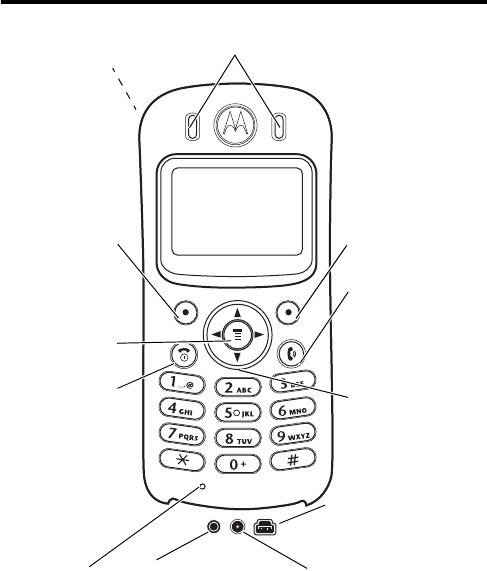
1
PRELIMINARY
Welcome
Earpiece
Internal Antenna
USB Connector
Insert data cable.
Right Soft Key
Perform functions
identified by right
display prompt.
Menu Key
Open a menu
when you see
G
in the display
Power/End Key
Press & hold to
power phone on
& off.
Press & release to
end phone calls,
exit menu system.
Send/Answer Key
Make and answer
calls; press in idle
to see recent
dialed calls.
Navigation Key
Scroll through lists,
set volume.
Left Soft Key
Perform functions
identified by left
display prompt.
Microphone Headset Connector
Power Connector
Insert charger.
Your C350 Series phone lets you change covers and keypads (see
“Changing Your Phone’s Cover” on page 15). Your phone may not
appear exactly as the phone image above.
Note that all key locations, sequences and functions remain the
same with any of the various covers.
UG.C330.GSM.book Page 1 Wednesday, January 8, 2003 2:00 PM
2
PRELIMINARY
Personal Communications Sector
600 North U.S. Highway 45
Libertyville, Illinois 60048
1-800-331-6456 (United States)
1-888-390-6456 (TTY/TDD United States)
1-800-461-4575 (Canada)
www.motorola.com
(United States)
www.motorola.ca
(Canada)
MOTOROLA and the Stylized M Logo are registered in the US Patent &
Trademark Office. All other product or service names are the property of
their respective owners.
© Motorola, Inc. 2002.
Software Copyright Notice
The Motorola products described in this manual may include copyrighted
Motorola and third party software stored in semiconductor memories or
other media. Laws in the United States and other countries preserve for
Motorola and third party software providers certain exclusive rights for
copyrighted software, such as the exclusive rights to distribute or
reproduce the copyrighted software. Accordingly, any copyrighted
software contained in the Motorola products may not be modified,
reverse-engineered, distributed, or reproduced in any manner to the
extent allowed by law. Furthermore, the purchase of the Motorola
products shall not be deemed to grant either directly or by implication,
estoppel, or otherwise, any license under the copyrights, patents, or
patent applications of Motorola or any third party software provider,
except for the normal, non-exclusive, royalty-free license to use that
arises by operation of law in the sale of a product.
Manual number: 6809457A28-O
Cover number: 8988485L49-O
UG.C330.GSM.book Page 2 Wednesday, January 8, 2003 2:00 PM

3
PRELIMINARY
Contents
Safety and General Information
. . . . . . . . . . . . . . . . . . . . 6
Getting Started
. . . . . . . . . . . . . . . . . . . . . . . . . . . . . . . . 12
What’s in the Box?. . . . . . . . . . . . . . . . . . . . . . . . . . . . . 12
About This Guide. . . . . . . . . . . . . . . . . . . . . . . . . . . . . . 12
Changing Your SIM Card. . . . . . . . . . . . . . . . . . . . . . . . 13
Changing Your Phone’s Cover. . . . . . . . . . . . . . . . . . . . 15
Resetting Your Phone . . . . . . . . . . . . . . . . . . . . . . . . . . 17
Charging the Phone . . . . . . . . . . . . . . . . . . . . . . . . . . . 18
Battery Use . . . . . . . . . . . . . . . . . . . . . . . . . . . . . . . . . . 18
Turning Your Phone On . . . . . . . . . . . . . . . . . . . . . . . . . 19
Adjusting the Volume. . . . . . . . . . . . . . . . . . . . . . . . . . . 20
Making a Call. . . . . . . . . . . . . . . . . . . . . . . . . . . . . . . . . 21
Answering a Call . . . . . . . . . . . . . . . . . . . . . . . . . . . . . . 21
Viewing Your Phone Number . . . . . . . . . . . . . . . . . . . . 22
Learning to Use Your Phone
. . . . . . . . . . . . . . . . . . . . . 23
Using the Display . . . . . . . . . . . . . . . . . . . . . . . . . . . . . 23
Using the 4-Way Navigation Key . . . . . . . . . . . . . . . . . . 26
Using Menus . . . . . . . . . . . . . . . . . . . . . . . . . . . . . . . . . 26
Entering Text . . . . . . . . . . . . . . . . . . . . . . . . . . . . . . . . . 28
Locking and Unlocking Your Phone. . . . . . . . . . . . . . . . 36
Changing a Code or Password . . . . . . . . . . . . . . . . . . . 38
If You Forget a Code or Password. . . . . . . . . . . . . . . . . 39
Locking and Unlocking the Keypad . . . . . . . . . . . . . . . . 39
Setting Up Your Phone
. . . . . . . . . . . . . . . . . . . . . . . . . . 40
Storing Your Name and Phone Number . . . . . . . . . . . . 40
Setting the Time and Date. . . . . . . . . . . . . . . . . . . . . . . 40
Setting a Ring Style. . . . . . . . . . . . . . . . . . . . . . . . . . . . 40
Setting Answer Options. . . . . . . . . . . . . . . . . . . . . . . . . 41
UG.C330.GSM.book Page 3 Wednesday, January 8, 2003 2:00 PM
4
PRELIMINARY
Setting a Wallpaper Image . . . . . . . . . . . . . . . . . . . . . . . 42
Selecting a Screen Saver . . . . . . . . . . . . . . . . . . . . . . . . 42
Zooming In and Out . . . . . . . . . . . . . . . . . . . . . . . . . . . . 43
Setting Display Contrast . . . . . . . . . . . . . . . . . . . . . . . . . 43
Adjusting the Backlight . . . . . . . . . . . . . . . . . . . . . . . . . . 44
Conserving Battery Power . . . . . . . . . . . . . . . . . . . . . . . 44
Calling Features
. . . . . . . . . . . . . . . . . . . . . . . . . . . . . . . . 45
Changing the Active Line . . . . . . . . . . . . . . . . . . . . . . . . 45
Redialing a Number . . . . . . . . . . . . . . . . . . . . . . . . . . . . 45
Using Automatic Redial. . . . . . . . . . . . . . . . . . . . . . . . . . 45
Using Caller ID . . . . . . . . . . . . . . . . . . . . . . . . . . . . . . . . 46
Canceling an Incoming Call . . . . . . . . . . . . . . . . . . . . . . 47
Turning Off a Call Alert . . . . . . . . . . . . . . . . . . . . . . . . . . 47
Calling an Emergency Number. . . . . . . . . . . . . . . . . . . . 47
Dialing International Numbers . . . . . . . . . . . . . . . . . . . . 48
Viewing the Received Calls or Dialed Calls List . . . . . . . 48
Returning an Unanswered Call . . . . . . . . . . . . . . . . . . . . 51
Using the Notepad . . . . . . . . . . . . . . . . . . . . . . . . . . . . . 51
Attaching a Number . . . . . . . . . . . . . . . . . . . . . . . . . . . . 52
Calling With Speed Dial . . . . . . . . . . . . . . . . . . . . . . . . . 53
Calling With 1-Touch Dial . . . . . . . . . . . . . . . . . . . . . . . . 53
Using Voicemail . . . . . . . . . . . . . . . . . . . . . . . . . . . . . . . 53
Using Call Waiting. . . . . . . . . . . . . . . . . . . . . . . . . . . . . . 55
Putting a Call on Hold . . . . . . . . . . . . . . . . . . . . . . . . . . . 56
Transferring a Call. . . . . . . . . . . . . . . . . . . . . . . . . . . . . . 56
Phone Features
. . . . . . . . . . . . . . . . . . . . . . . . . . . . . . . . . 58
Main Menu . . . . . . . . . . . . . . . . . . . . . . . . . . . . . . . . . . . 58
Feature Quick Reference . . . . . . . . . . . . . . . . . . . . . . . . 60
UG.C330.GSM.book Page 4 Wednesday, January 8, 2003 2:00 PM
5
PRELIMINARY
Specific Absorption Rate Data
. . . . . . . . . . . . . . . . . . . 71
Additional Health and Safety Information
. . . . . . . . . . 73
Warranty
. . . . . . . . . . . . . . . . . . . . . . . . . . . . . . . . . . . . . 81
Index
. . . . . . . . . . . . . . . . . . . . . . . . . . . . . . . . . . . . . . . . . 87
Wireless Phone Safety Tips
. . . . . . . . . . . . . . . . . . . . . . 95
UG.C330.GSM.book Page 5 Wednesday, January 8, 2003 2:00 PM

6
PRELIMINARY
Safety and General
Information
IMPORTANT INFORMATION ON SAFE AND EFFICIENT OPERATION.
READ THIS INFORMATION BEFORE USING YOUR PHONE.
The information provided in this document supersedes the general safety
information contained in user guides published prior to July 2000. For
information regarding radio use in a hazardous atmosphere please refer
to the Factory Mutual (FM) Approval Manual Supplement or Instruction
Card, which is included with radio models that offer this capability.
This device complies with Part 15 of the FCC Rules. Operation is subject
to the following two conditions: (1) this device may not cause harmful
interference, and (2) this device must accept any interference received,
including interference that may cause undesired operation.
RF Operational Characteristics
Your phone contains a transmitter and a receiver. When it is ON, it
receives and transmits radio frequency (RF) energy. The phone operates
in the frequency range of 824 MHz to 849 MHz and 1850 MHz to 1910
MHz in digital mode.
When you communicate with your phone, the system handling your call
controls the power levels at which your phone transmits. The output
power level typically may vary over a range from 0.0 Watts to 1.0 Watt for
the 800 MHz band and 0.0 Watts to 1.0 Watt for the 1900 MHz band.
Exposure To Radio Frequency Energy
Your Motorola phone is designed to comply with the following national and
international standards and guidelines regarding exposure of human
beings to radio frequency electromagnetic energy:
•
United States Federal Communications Commission, Code of
Regulations; 47 CFR part 2 sub-part J
UG.C330.GSM.book Page 6 Wednesday, January 8, 2003 2:00 PM
7
PRELIMINARY
•
American National Standards Institute (ANSI) / Institute of Electrical
and Electronic Engineers (IEEE) C95. 1-1992
•
Institute of Electrical and Electronic Engineers (IEEE) C95.1-1999
Edition
•
National Council on Radiation Protection and Measurements
(NCRP) of the United States, Report 86, 1986
•
International Commission on Non-Ionizing Radiation Protection
(ICNIRP) 1998
•
Ministry of Health (Canada) Safety Code 6. Limits of Human
Exposure to Radiofrequency Electromagnetic Fields in the
Frequency Range from 3 kHz to 300 GHz, 1999
•
Australian Communications Authority Radiocommunications
(Electromagnetic Radiation-Human Exposure) Standard 1999
To assure optimal phone performance and make sure human exposure to
radio frequency electromagnetic energy is within the guidelines set forth
in the above standards, always adhere to the following procedures:
Portable Phone Operation and EME Exposure
Antenna Care
Use only the supplied or an approved replacement antenna.
Unauthorized antennas, modifications, or attachments could damage the
phone and may violate FCC regulations.
Do NOT hold the antenna when the phone is in use.
Holding the
antenna affects call quality and may cause the phone to operate at a
higher power level than needed.
Phone Operation
When placing or receiving a phone call, hold your phone as you would a
wireline telephone.
Speak directly into the microphone.
UG.C330.GSM.book Page 7 Wednesday, January 8, 2003 2:00 PM
8
PRELIMINARY
Body-Worn Operation
To maintain compliance with FCC/Health Canada RF exposure
guidelines, if you wear a phone on your body when transmitting, always
place the phone in a Motorola-supplied or approved clip, holder, holster,
case, or body harness for this product. Use of non-Motorola-approved
accessories may exceed FCC/Health Canada RF exposure guidelines. If
you do not use one of the Motorola-supplied or approved body-worn
accessories, and are not using the phone held in the normal use position,
ensure the phone and its antenna are at least one inch
(2.5 centimeters) from your body when transmitting.
Data Operation
When using any data feature of the phone, with or without an accessory
cable,
position the phone and its antenna at least one inch
(2.5 centimeters) from your body.
Approved Accessories
For a list of approved Motorola accessories, visit our website at
www.mot.com
.
Electromagnetic Interference/Compatibility
Note:
Nearly every electronic device is susceptible to electromagnetic
interference (EMI) if inadequately shielded, designed, or otherwise
configured for electromagnetic compatibility.
Facilities
To avoid electromagnetic interference and/or compatibility conflicts, turn
off your phone in any facility where posted notices instruct you to do so.
Hospitals or health care facilities may be using equipment that is sensitive
to external RF energy.
Aircraft
When instructed to do so, turn off your phone when on board an aircraft.
Any use of a phone must be in accordance with applicable regulations per
airline crew instructions.
UG.C330.GSM.book Page 8 Wednesday, January 8, 2003 2:00 PM
9
PRELIMINARY
Medical Devices
Pacemakers
The Advanced Medical Technology Association recommends that a
minimum separation of 6 inches (15 centimeters) be maintained between
a handheld wireless phone and a pacemaker. These recommendations
are consistent with the independent research by, and recommendations
of, the United States Food and Drug Administration.
Persons with pacemakers should:
•
ALWAYS keep the phone more than six inches (15 centimeters)
from your pacemaker when the phone is turned ON.
•
NOT carry the phone in the breast pocket.
•
use the ear opposite the pacemaker to minimize the potential for
interference.
•
turn OFF the phone immediately if you have any reason to suspect
that interference is taking place.
Hearing Aids
Some digital wireless phones may interfere with some hearing aids. In the
event of such interference, you may want to consult your hearing aid
manufacturer to discuss alternatives.
Other Medical Devices
If you use any other personal medical device, consult the manufacturer of
your device to determine if it is adequately shielded from RF energy. Your
physician may be able to assist you in obtaining this information.
Safety and General Use While Driving
Check the laws and regulations on the use of phones in the area where
you drive. Always obey them.
When using your phone while driving, please:
•
give full attention to driving and to the road.
•
use hands-free operation, if available.
UG.C330.GSM.book Page 9 Wednesday, January 8, 2003 2:00 PM
10
PRELIMINARY
•
pull off the road and park before making or answering a call if driving
conditions so require.
Operational Warnings
For Vehicles With an Air Bag
Do not place a portable phone in the area over an air bag or in the air bag
deployment area. Air bags inflate with great force. If a portable phone is
placed in the air bag deployment area and the air bag inflates, the phone
may be propelled with great force and cause serious injury to occupants
of the vehicle.
Potentially Explosive Atmospheres
Turn off your phone prior to entering any area with a potentially explosive
atmosphere, unless the phone is a model specifically identified as being
“Intrinsically Safe.” Do not remove, install, or charge batteries in such
areas. Sparks in a potentially explosive atmosphere can cause an
explosion or fire resulting in bodily injury or even death.
Note:
The areas with potentially explosive atmospheres referred to above
include fueling areas such as below decks on boats, fuel or chemical
transfer or storage facilities, areas where the air contains chemicals or
particles, such as grain, dust, or metal powders, and any other area
where you would normally be advised to turn off your vehicle engine.
Areas with potentially explosive atmospheres are often but not always
posted.
Blasting Caps and Areas
To avoid possible interference with blasting operations, turn OFF your
phone when you are near electrical blasting caps, in a blasting area, or in
areas posted: “Turn off two-way radio.” Obey all signs and instructions.
UG.C330.GSM.book Page 10 Wednesday, January 8, 2003 2:00 PM
11
PRELIMINARY
Operational Cautions
Antennas
Do not use any portable phone that has a damaged antenna.
If a
damaged antenna comes into contact with your skin, a minor burn can
result.
Batteries
All batteries can cause property damage and/or bodily injury such as
burns if a conductive material such as jewelry, keys, or beaded chains
touches exposed terminals. The conductive material may complete an
electrical circuit (short circuit) and become quite hot. Exercise care in
handling any charged battery, particularly when placing it inside a pocket,
purse, or other container with metal objects.
UG.C330.GSM.book Page 11 Wednesday, January 8, 2003 2:00 PM
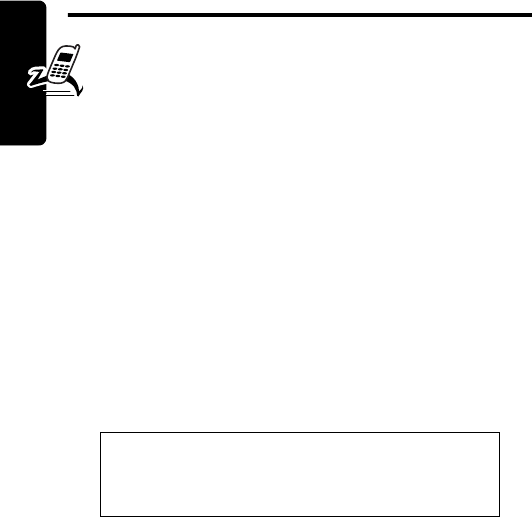
12
PRELIMINARY
Getting Started
Getting Started
What’s in the Box?
Your digital wireless phone has a permanent internal
battery, and typically comes equipped with a charger.
Other accessory options can customize your phone for
maximum performance and portability.
To purchase Motorola Original™ accessories, please
contact the Motorola Customer Call Center at
1-800-331-6456 in the United States or 1-800-461-4575 in
Canada.
About This Guide
This user guide introduces you to your Motorola wireless
phone.
To obtain the reference guide for your phone, or another
copy of this user guide, see the Motorola Web site at:
http://motorola.com/consumer/manuals
or contact the Motorola Customer Call Center at 1-800-
331-6456 in the United States or 1-800-461-4575 in
Canada.
Note:
A reference guide for your phone is also
available that describes your phone’s features in
more detail.
UG.C330.GSM.book Page 12 Wednesday, January 8, 2003 2:00 PM
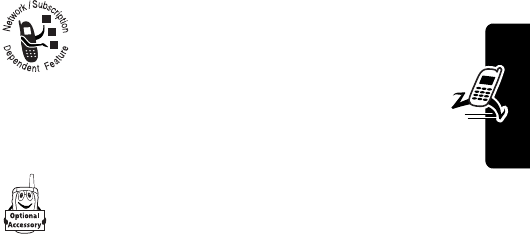
13
PRELIMINARY
Getting Started
Optional Features
This label identifies an optional network, SIM
card, or subscription-dependent feature that
may not be offered by all service providers in
all geographical areas. Contact your service
provider for more information.
Optional Accessories
This label identifies a feature that requires an
optional Motorola Original™ accessory.
Changing Your SIM Card
Your SIM (Subscriber Identity Module) card contains your
phone number, service details, and phonebook/message
memory. It must be installed in the base of the phone. If
you have problems with your SIM card, contact your
service provider.
Since your C350 Series phone lets you change covers and
keypads, it may not appear exactly as the phone pictured.
All key locations, sequences, and functions remain the
same with any of the various covers.
Caution:
Do not bend or scratch your SIM card. Avoid
exposing your SIM card to static electricity, water, or dirt.
UG.C330.GSM.book Page 13 Wednesday, January 8, 2003 2:00 PM
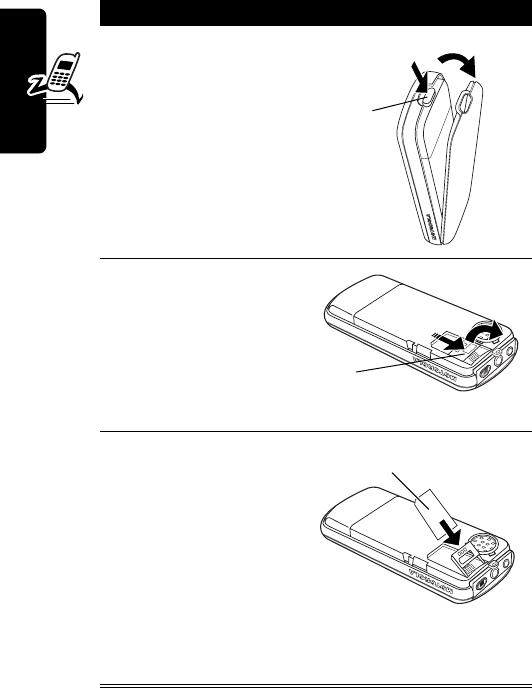
14
PRELIMINARY
Getting Started
To Change Your SIM Card
1
Press down on the
cover release
button at the top of
your phone
2
Pull the top of the
phone’s back
cover to release it
3
Slide the metal
SIM card holder
back to unlock it,
then lift up to open
it slightly. Remove
the old SIM card, if
necessary.
4
Insert the new SIM
card in the holder
with the cut corner
on the upper left
and the gold plate
facing down.
5
Close the SIM
card holder and
slide it forward to
lock it.
Release
button
12
SIM
card
holder 3
SIM card
4
UG.C330.GSM.book Page 14 Wednesday, January 8, 2003 2:00 PM
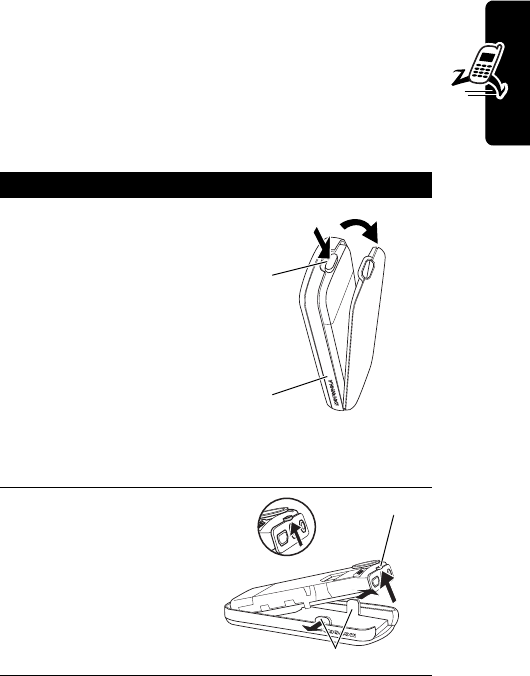
15
PRELIMINARY
Getting Started
Changing Your Phone’s Cover
Your phone uses a convertible cover, keypad, and (in
some cases) side band that you may replace to
completely change its appearance. Your phone may
not appear exactly as the phone pictured. All key
locations, sequences, and functions remain the same
with any of the various covers.
To Remove a Cover and Keypad
1
Press down on the
cover release
button at the top of
your phone.
2
Pull the top of the
phone’s back
cover to release it.
Note:
If your cover
has a removable
side band, remove
it at this point.
3
Pull the side tabs
away from the
phone, then
4
Lift up on the
lanyard loop to pull
the phone out of
the front cover.
Release
button
12
Side
band
Lanyard loop
Side tabs
3
4
UG.C330.GSM.book Page 15 Wednesday, January 8, 2003 2:00 PM
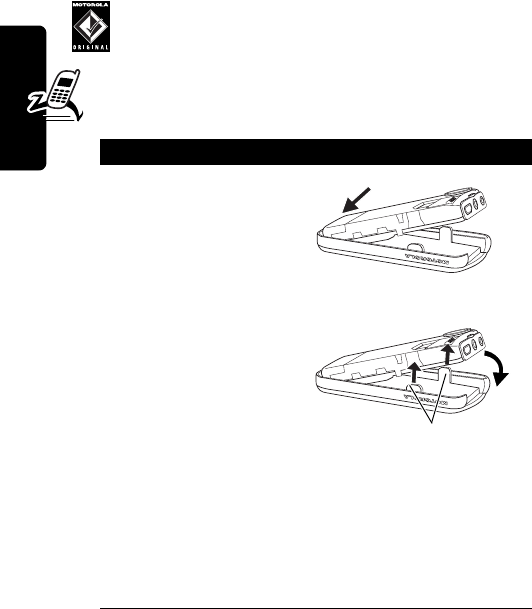
16
PRELIMINARY
Getting Started
Note:
Always use Motorola Original™ covers. The
phone warranty does not cover damage caused
from using non-Motorola accessories.
Always use the keypad and side band (if applicable)
that matches the new cover.
To Install a Cover and Keypad
Note:
If your phone
has an end cap, install
it before attaching the
front cover.
1
Slide the top of the
phone into the top
of the new front
cover.
2
Press the bottom
of the phone into
the front cover
until the side tabs
snap into place.
Note:
If your cover
has a removable
side band, attach it
at this point.
Side tabs
1
2
UG.C330.GSM.book Page 16 Wednesday, January 8, 2003 2:00 PM
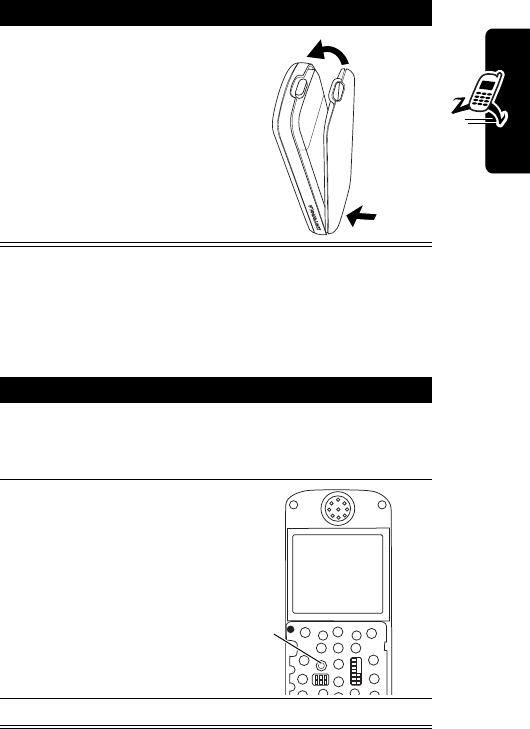
17
PRELIMINARY
Getting Started
Resetting Your Phone
If your phone becomes frozen on a single display, error
message, or power up, reset your phone as follows:
3
Insert the bottom
of the back cover.
4
Press the top of
the back cover
down until it hooks
over the cover
release button.
To Reset Your Phone
1
Remove your phone’s back and front cover as
described in “Changing Your Phone’s Cover” on
page 15.
2
Use a small object
to press the Reset
button on the front
of your phone.
Your phone
display should be
restored.
3
Replace your phone’s cover.
To Install a Cover and Keypad
3
4
Reset
button
UG.C330.GSM.book Page 17 Wednesday, January 8, 2003 2:00 PM
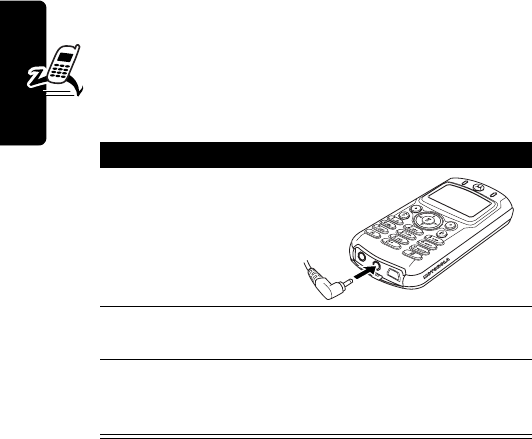
18
PRELIMINARY
Getting Started
Charging the Phone
Your phone has a built-in battery. Before you can use
your phone, you need to fully charge the battery, as
indicated by the following instructions. Some batteries
perform best after several full charge/discharge cycles.
Note:
When you charge the battery, the battery level
indicator in the upper right corner of the display shows how
much of the charging process is complete. See the
“Battery Level Indicator” item on page 24.
Battery Use
Your C350 Series phone has a permanent internal battery.
To maximize your battery’s performance:
To Charge the Phone
1
Plug the travel
charger into the
middle jack on
the bottom of
your phone.
2
Plug the other end of the travel charger into the
appropriate electrical outlet.
3
When your phone indicates that it is fully
charged (
Charge Complete
), remove the travel
charger.
UG.C330.GSM.book Page 18 Wednesday, January 8, 2003 2:00 PM
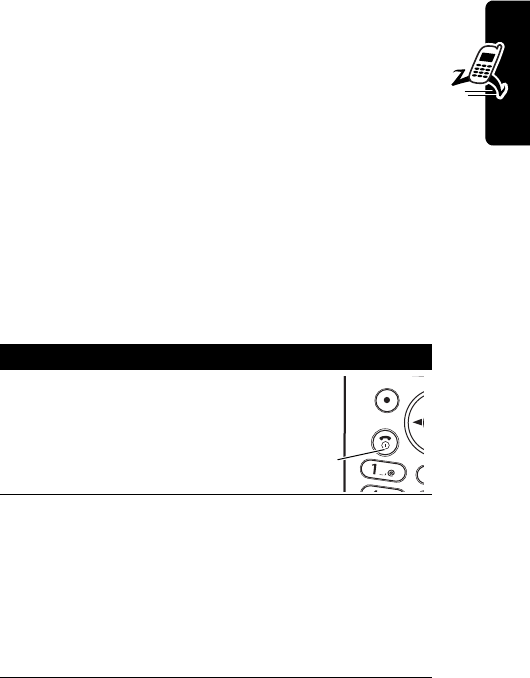
19
PRELIMINARY
Getting Started
•
Always use Motorola Original™ battery chargers. The
phone warranty does not cover damage caused from
using non-Motorola battery chargers.
•
New phones or phones that have been stored for
long periods of time may require a longer initial
charge time.
•
Maintain the phone at or near room temperature when
charging.
•
Do not expose phones to temperatures below -10°C
(14°F) or above 45°C (113°F). Always take your
phone with you when you leave your vehicle.
Turning Your Phone On
To Turn Your Phone On
1
Press and hold
O
(the
End/Power key)
2
If necessary, enter your SIM card PIN code and
press
OK
(
+
) to unlock your SIM card
Note:
If you enter an incorrect PIN code three
times in a row, your SIM card is disabled and
your phone displays the message
SIM Blocked
.
(For more information, see “Locking the SIM
Card” on page 74.)
End/
Power Key
UG.C330.GSM.book Page 19 Wednesday, January 8, 2003 2:00 PM
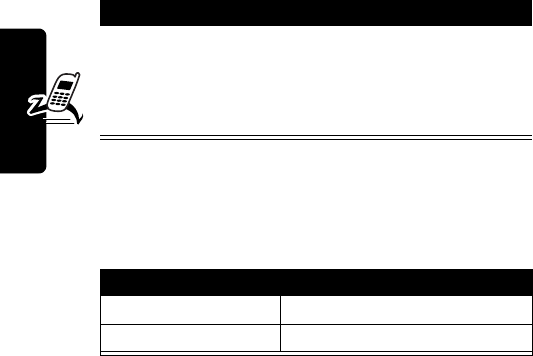
20
PRELIMINARY
Getting Started
Adjusting the Volume
You can adjust your phone’s earpiece and ring tone
volume by pressing right and left on the
S
:
Tip:
At the lowest ring tone volume setting, press
S
left
once to switch to vibrate alert. Press it again to switch to
silent alert. Press
S
right to cycle back to vibrate alert,
then ring alert.
3
If necessary, enter your four-digit unlock code
and press
OK
(
+
) to unlock your phone
Note:
The unlock code is originally set to 1234.
(For more information, see page 36.)
When You Can Adjust
you are in a call earpiece speaker volume
the display is idle ring tone volume
To Turn Your Phone On
UG.C330.GSM.book Page 20 Wednesday, January 8, 2003 2:00 PM
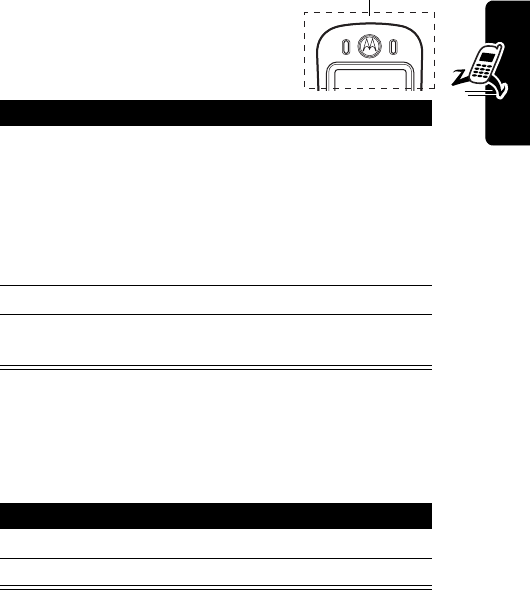
21
PRELIMINARY
Getting Started
Making a Call
There is a built-in antenna in the top
of your phone. Do not block the
antenna while you are on a call.
Answering a Call
When you receive a call, your phone rings and/or vibrates
and displays an incoming call message.
Note:
If the phone is locked, you must unlock it to answer
the call.
Press To
1
keypad keys dial the phone number
Tip:
If you make a mistake,
press
DELETE
(
-
) to delete
the last digit, or press and
hold
DELETE
(
-
) to clear all
digits.
2
N
make the call
3
O
end the call and “hang up” the
phone when you are finished
To Answer a Call
1
Press
N
or
ANSWER
(
+
)
2
Press
O
(end key) when the call is done.
Built-in antenna
UG.C330.GSM.book Page 21 Wednesday, January 8, 2003 2:00 PM

22
PRELIMINARY
Getting Started
Viewing Your Phone Number
To view your phone number from the idle display, press
M#
.
While you are on a call, press
M
>
My Tel. Numbers
.
Your phone number must be stored on your SIM card
to use this feature. To store your phone number on the SIM
card, see page 40. If you do not know your phone number,
contact your service provider.
UG.C330.GSM.book Page 22 Wednesday, January 8, 2003 2:00 PM
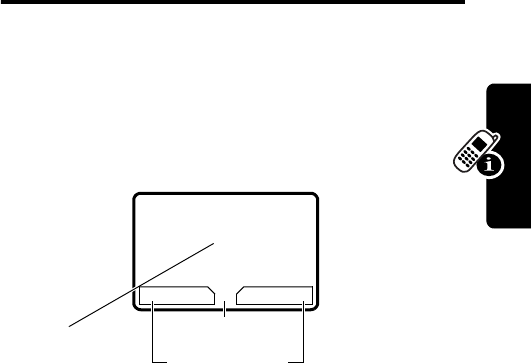
23
PRELIMINARY
Learning to Use Your Phone
Learning to Use Your
Phone
See page 1 for a basic phone diagram.
Using the Display
The idle display (shown below) is the standard display
when you are not on a call or using the menu.
The
G
(menu) indicator at the bottom center of the display
indicates you can press the menu key (
M
) to go to the
main menu to see more features.
Labels at the bottom corners of the display show the
current soft key functions. Press the left soft key (
-
) or
right soft key (
+
) to perform the function indicated by the
left or right soft key label.
12:00
MYMENU MESSAGE
Clock Menu Indicator
G
5| U; tf9
Y
Soft Key Labels
UG.C330.GSM.book Page 23 Wednesday, January 8, 2003 2:00 PM
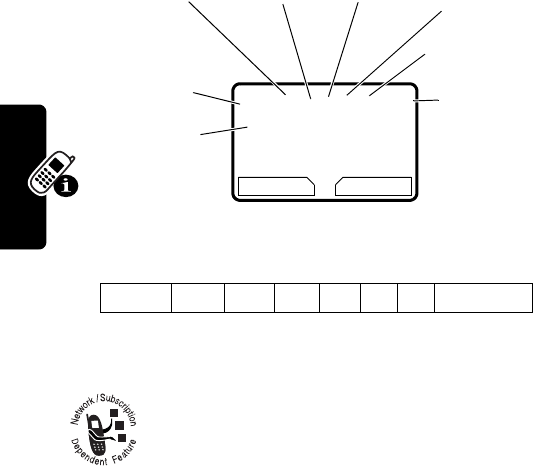
24
PRELIMINARY
Learning to Use Your Phone
At the top of the display are a number of status indicators:
➊
Signal Strength Indicator
Shows the strength of your
phone’s connection with the network.
You cannot make or answer calls when the “no signal”
indicator is displayed.
➋
Service Indicator
Indicates if you have a
GPRS connection (
|
). GPRS allows faster data
transfer speeds, and your service provider may
indicate when a GPRS packet data connection
is active. The indicator does not mean that you are in a
call; only that you are registered on the network via a
GPRS connection.
➌
In Use Indicator
Indicates when a call is in progress,
and when you have a secure (
G
) or insecure (
F
)
connection.
Strong
5
4
3
2
1
0
No signal
12:00
MYMENU MESSAGE
➊
Signal
Strength
Indicator
➐
Battery
Level
Indicator
➋
Service
Indicator
➌
In Use
Indicator
➎
Text Entry
Indicator
(if applies)
➏
Message
Indicator
➍
Roam
Indicator
➑
Alert Type
Indicator
G
5| U; tf9
Y
UG.C330.GSM.book Page 24 Wednesday, January 8, 2003 2:00 PM
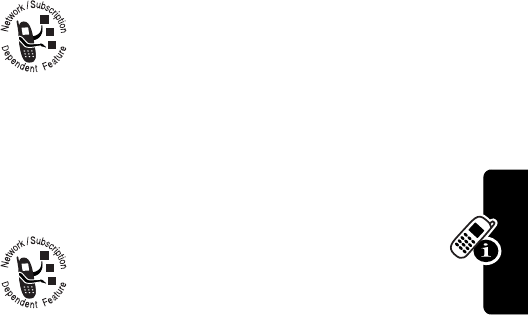
25
PRELIMINARY
Learning to Use Your Phone
➍
Roam Indicator
Appears when your phone
uses another network system outside your
home network. When you leave your home
network area, your phone roams or seeks
another network. Icons here can also indicate your text
entry mode (alpha, numeric, symbol, etc.)
➎
Text Entry Indicator
Indicates your Text Entry Method
whenever you are in a text editor (Tap, iTap, etc.). See
“Entering Text” on page 28.
➏
Message Indicator
Indicates when you
have an active Chat session, or when you
have a new voice or text message waiting.
➐
Battery Level Indicator
Shows the amount of charge
left in your battery. The more bars visible, the greater the
charge.
Recharge your battery as soon as possible when you see
the
Low Battery
warning message and hear the low
battery alert.
Note:
When you charge the phone, the battery level
indicator instead shows how much of the charging process
is complete. See “Charging the Phone” on page 18.
➑
Alert Type Indicator
Shows the current selected alert
profile. The default alert setting is loud ring.
High
9
8
7
6
Low
Y
= loud ring
X
=soft ring
W
=vibrate
_
= vibrate and ring
UG.C330.GSM.book Page 25 Wednesday, January 8, 2003 2:00 PM
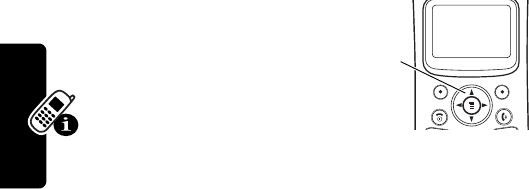
26
PRELIMINARY
Learning to Use Your Phone
Using the 4-Way Navigation
Key
Use the 4-way navigation key
like a joystick to navigate the
menu system, change feature
settings, and play games.
Tip:
Down and up are the
primary movements within
menus. Move left and right to change feature settings,
navigate the datebook, and edit text.
Using Menus
From the idle display, press
M
to display the main menu.
Selecting a Menu Feature
From the idle display, select a menu feature as follows:
This example shows that from the idle display, you must
press
M
, scroll to and select
Recent Calls
, then scroll to
and select
Dialed Calls
to see the dialed calls list. Use
S
to scroll, and the left/right soft keys to select the functions
listed in the bottom left and right corners of the display.
a
= silent
Find the Feature
M
>
Recent Calls
>
Dialed Calls
Navigation
Key
UG.C330.GSM.book Page 26 Wednesday, January 8, 2003 2:00 PM
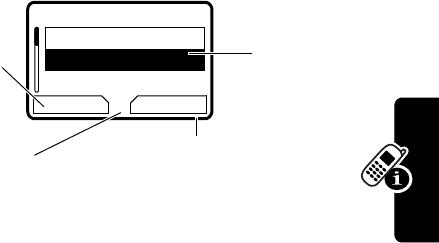
27
PRELIMINARY
Learning to Use Your Phone
Selecting a Feature Option
Some features require you to select an item from a list:
•
Press
S
to scroll up or down to highlight an item.
•
In a numbered list, press a number key to highlight the
item.
•
In an alphabetized list, press a key repeatedly to cycle
through the letters on the key and highlight the closest
matching list item.
•
When an item has a list of possible values, press
S
to the left or right to scroll and select a value.
•
When an item has a list of possible numeric values,
press a number key to set the value.
Dialed Calls
10)John Smith
9)Mary Smith
BACK VIEW
59
G
Press
BACK
(
-
)
to display
the previous
screen.
Press
M
to open
the sub-menu.
Highlighted
item
Press
VIEW
(
+
) to display details
for the highlighted item.
UG.C330.GSM.book Page 27 Wednesday, January 8, 2003 2:00 PM
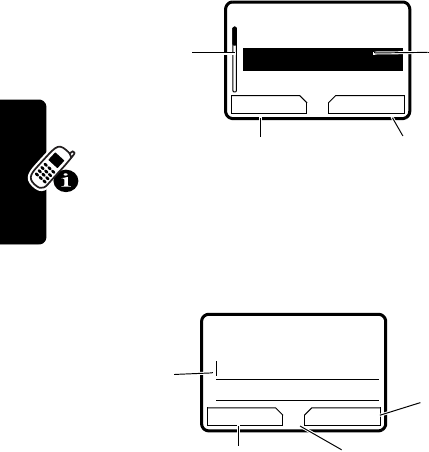
28
PRELIMINARY
Learning to Use Your Phone
Entering Text
Some features require you to enter information:
The message center lets you compose and send text
messages. A flashing cursor shows where text will appear:
Entry Details
Name:_____________
No.:_______________
CANCEL CHANGE
59
G
Press
S
to
scroll down to
additional
items.
Press
CANCEL
(
-
) to exit
without making changes.
DONE
(
-
) displays when you
enter or edit information.
Press
CHANGE
(
+
)
to edit the
information.
Highlighted
item
Msg:
CANCEL INSERT
Press
INSERT
(
+
)
to view and
insert stored
text or
objects.
Press
CANCEL
(
-
) to exit
without making changes.
Flashing
cursor
indicates
insertion
point.
Press
M
to open the
sub-menu.
G
59
UG.C330.GSM.book Page 28 Wednesday, January 8, 2003 2:00 PM
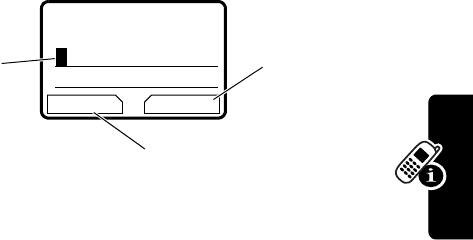
29
PRELIMINARY
Learning to Use Your Phone
When you enter text using the standard tap method (see
page 30), the flashing cursor changes to a block cursor,
and the soft key functions change:
Choosing a Text Mode
Multiple text entry modes make it easy for you to enter
names, numbers, and messages.
Press
M
>
Entry Method
from any text entry screen to
select a text mode:
iTAP
Let the phone predict each word as
you enter it, then choose the word
from a list (see “Using iTAP™ Software
Text Entry Method” on page 31).
Tap Method
Enter characters one at a time by
pressing the key for the letter, number,
or symbol (see “Using the Tap Method”
on page 30). This is the standard
mode for entering text on your phone.
Numeric
Enter numbers only.
Msg:
T
DELETE OK
Press
OK
(
+
)
to accept
and store
the text.
Press
DELETE
(
-
)
to delete the character
to the left of the insertion
point.
Block
cursor
indicates
current
highlighted
character.
After 2 seconds, the
block cursor reverts to
a flashing cursor and
moves to the next
position.
G
59
UG.C330.GSM.book Page 29 Wednesday, January 8, 2003 2:00 PM
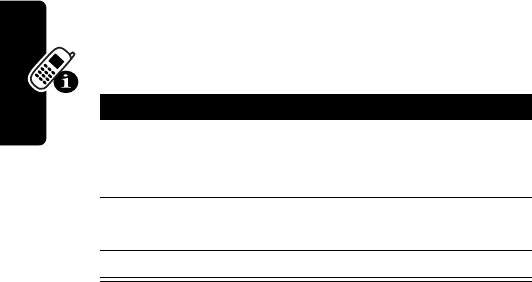
30
PRELIMINARY
Learning to Use Your Phone
Note:
The text mode you select remains active until you
change it by selecting another mode.
Using the Tap Method
This is the standard mode for entering text on your phone.
Press
M
>
Entry Method
from a text entry screen and
select
Tap Method
.
Tap Method Text Entry Rules
•
Press a number key repeatedly to cycle through its
characters. See the chart on page 31.
•
If you do not press a key for two seconds, the
character in the block cursor is accepted, and the
cursor moves to the next position.
•
Press
S
left or right to move the flashing cursor to
the left or right in a text message.
•
The first character of every sentence is capitalized.
Press
S
down to force the character to lowercase
while it is highlighted by the block cursor.
Symbol
Enter symbols only (see “Using
Symbol Mode” on page 35).
Press To
1
A number key
one or more
times
select a letter, number, or
symbol shown in the chart on
page 31.
2
Number keys enter the remaining
characters
3
OK
(
+
) store the text
UG.C330.GSM.book Page 30 Wednesday, January 8, 2003 2:00 PM
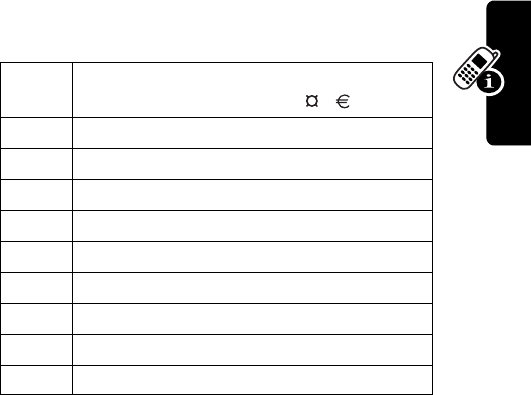
31
PRELIMINARY
Learning to Use Your Phone
•
Your phone may support multiple languages. The
current language setting determines whether a new
message begins on the left or right side of the display.
•
If you enter or edit information and do not want to save
your changes, press
O
to exit without saving.
Character Chart
Use this chart as a guide for entering characters with the
tap method.
Note:
This chart may not reflect the exact character set
available on your phone.
Using iTAP™ Software Text Entry Method
iTAP™ software provides a predictive text entry method
that lets you enter a word using one keypress per letter.
1
space . 1 ? ! , @ _ & ~ : ; "
- ( ) ' ¿ ¡ % £ $ ¥
2
a b c 2 ä å á à â ã
α
β
ç
3
d e f 3
δ
ë é è ê
φ
4
g h i 4 ï í î
γ
5
j k l 5
λ
6
m n o 6 ñ ö ø ó ò ô õ
ω
7
p q r s 7
π
ß
σ
8
t u v 8
θ
ü ú ù û
9
w x y z 9
ξ ψ
0
+ - 0 x * / \ [ ] = > < # §
UG.C330.GSM.book Page 31 Wednesday, January 8, 2003 2:00 PM
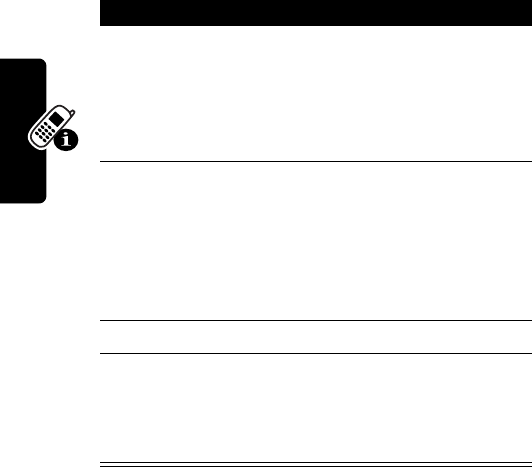
32
PRELIMINARY
Learning to Use Your Phone
Press
M
>
Entry Method
from a text entry screen and
select
iTAP
.
Entering Words
Press To
1
A number key
one time
enter the first letter of the
word
The letters associated with
the key are shown at the
bottom of the display.
2
Number keys
(one per letter)
enter the rest of the word
Alternative words and letter
combinations are shown at
the bottom of the display. The
word choices are updated
with each keypress.
3
S
right or left highlight the word you want
4
SELECT
(
+
) enter the word at the flashing
cursor
A space is automatically
inserted after the word.
UG.C330.GSM.book Page 32 Wednesday, January 8, 2003 2:00 PM
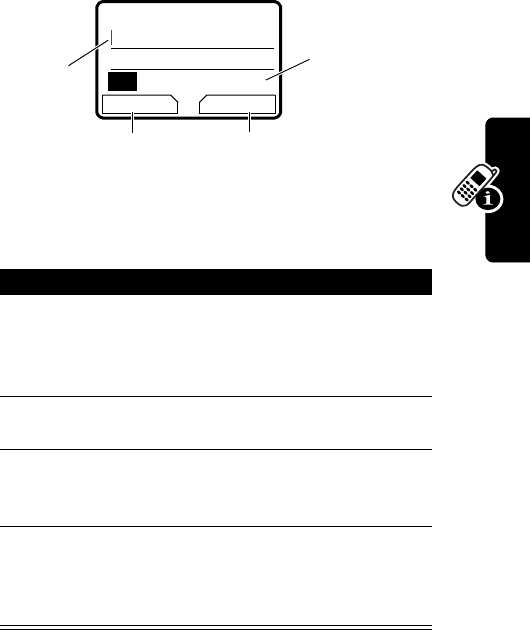
33
PRELIMINARY
Learning to Use Your Phone
For example, to spell “art,” press
2
7
8
. The display
shows:
Entering Novel Words
If the word you want is not displayed in the iTAP software:
Press To
1
DELETE
(
-
) one or
more times
delete letters until you
see a letter combination
that matches the start of
the word
2
S
left or right highlight the letter or
letter combination
3
SELECT
(
+
), then
press
S
to the left
shift the text entry cursor
to the left and “lock” the
selected word portion
4
Number keys and
S
enter letters and
highlight letter
combinations to spell the
word
Art Apt Cpu Cst Cru
c
DELETE SELECT
Press
SELECT
(
+
) to insert
the highlighted word.
Press
DELETE
(
-
) to
clear the last letter entered.
Flashing
cursor
indicates
insertion
point.
Press
S
to
scroll and see
additional word
choices.
G
59
UG.C330.GSM.book Page 33 Wednesday, January 8, 2003 2:00 PM
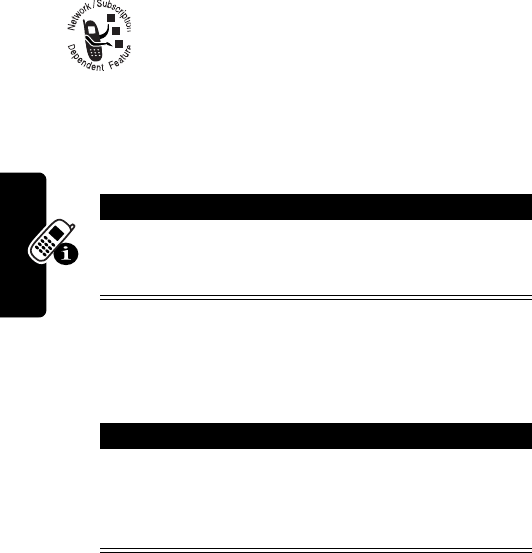
34
PRELIMINARY
Learning to Use Your Phone
Your phone stores the unrecognized word, and
includes it in the list of alternative word choices
the next time you enter it. When memory space
for storing unrecognized words is filled, your
phone deletes the oldest words as new words
are added.
Entering Punctuation
Using Capitalization
The first word of a sentence is automatically capitalized,
with the words that follow in lowercase.
Press To
0
or
1
enter punctuation or other
characters (see the chart on
page 31).
Press To
S
up or down change the words to initial
character capitalized, all
uppercase characters, or all
lowercase characters
UG.C330.GSM.book Page 34 Wednesday, January 8, 2003 2:00 PM
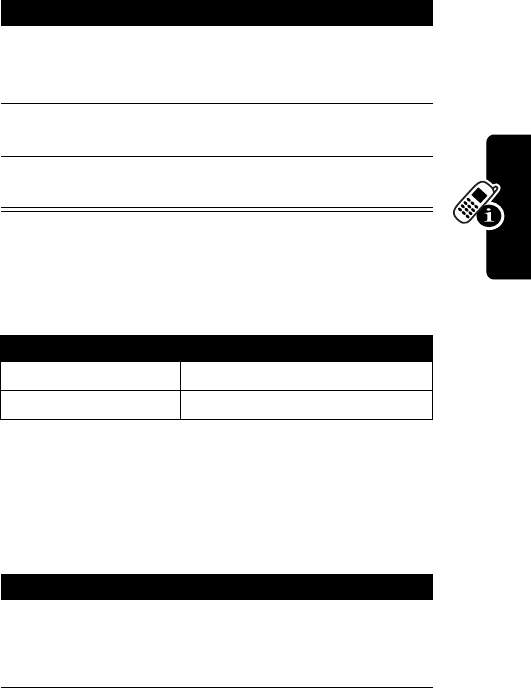
35
PRELIMINARY
Learning to Use Your Phone
Entering Numbers
Deleting Letters and Words
Place the cursor to the right of the text you want to delete,
and then:
Using Symbol Mode
To enter symbol characters in a message, press
M
>
Entry Method
from any text entry screen and select
Symbol
.
Do This To
1
Enter the first
digit and then
highlight it
put the iTAP software in
number entry mode
2
Press number
keys
add digits to the number
3
Press
SELECT
(
+
)
enter the number
Do This To
Press
DELETE
(
-
) delete one letter at a time
Hold
DELETE
(
-
) delete the entire message
Press To
1
A number key
one time
display its symbol options at
the bottom of the display.
See the chart on page 36.
UG.C330.GSM.book Page 35 Wednesday, January 8, 2003 2:00 PM
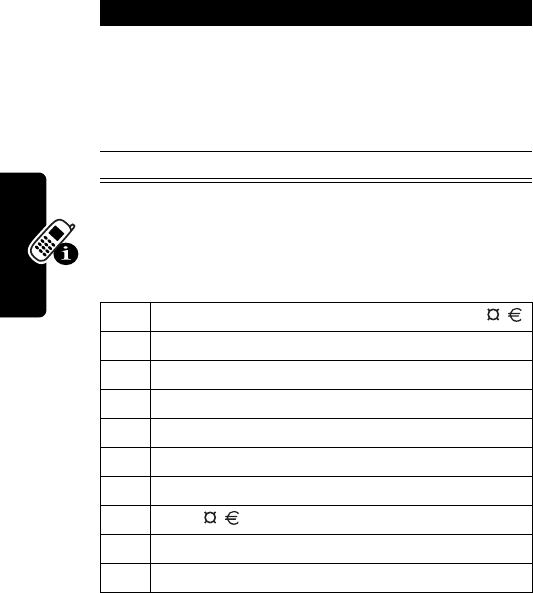
36
PRELIMINARY
Learning to Use Your Phone
Symbol Chart
Use this chart as a guide for entering symbols in
symbol mode.
Locking and Unlocking Your
Phone
You can lock your phone manually or set your phone to
lock automatically whenever you turn it off.
2
S
left or right
or
the number key
repeatedly
highlight the symbol you want
3
SELECT
(
+
) enter the symbol
1
space . ? ! , @ _ & ~ : ; " - ( ) ' ¿ ¡ % £ $ ¥
2
@ _ \
3
/ : ;
4
" & '
5
( ) [ ] { }
6
¿ ¡ ~
7
< > =
8
$ £ ¥
9
# % *
0
+ - x * / = > < # §
Press To
UG.C330.GSM.book Page 36 Wednesday, January 8, 2003 2:00 PM
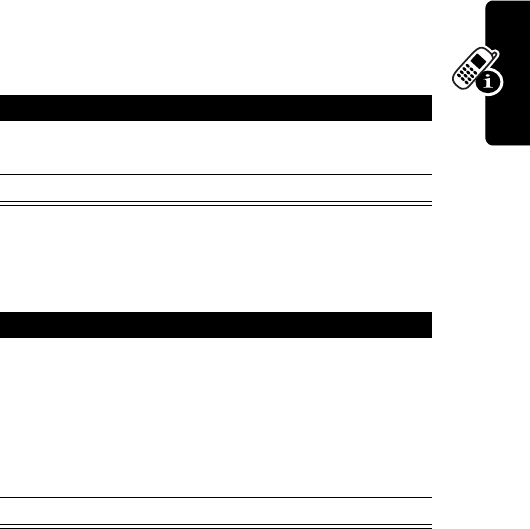
37
PRELIMINARY
Learning to Use Your Phone
A locked phone still rings or vibrates for incoming calls or
messages, but you must unlock it to answer. To use a
locked phone, enter the unlock code.
You can make emergency calls on your phone even when
it is locked. See page 47.
Locking Your Phone Manually
Unlocking Your Phone
At the
Enter Unlock Code
prompt:
Find the Feature
M
>
Settings
>
Security
>
Phone Lock
>
Lock Now
Press To
1
keypad keys enter your four-digit unlock
code
2
OK
(
+
) lock the phone
Press To
1
keypad keys enter your four-digit unlock
code
The unlock code is originally
set to 1234. If necessary, see
“If You Forget a Code or
Password” on page 39.
2
OK
(
+
) unlock your phone
UG.C330.GSM.book Page 37 Wednesday, January 8, 2003 2:00 PM

38
PRELIMINARY
Learning to Use Your Phone
Setting Your Phone to Lock Automatically
You can set your phone to lock every time you turn it off:
Changing a Code or Password
Your phone’s four-digit unlock code is originally set to
1234, and the six-digit security code is originally set to
000000. Your service provider may reset these numbers
before you receive your phone.
If your service provider has not reset these numbers, we
recommend that you change them to prevent other users
from accessing your personal information or modifying
your phone settings. The unlock code must contain four
digits, and the security code must contain six digits.
To change a code or password:
Find the Feature
M
>
Settings
>
Security
>
Phone Lock
>
Automatic Lock
>
On
Press To
1
keypad keys enter your four-digit unlock
code
2
OK
(
+
) set the phone to lock
automatically
Find the Feature
M
>
Settings
>
Security
>
New Passwords
UG.C330.GSM.book Page 38 Wednesday, January 8, 2003 2:00 PM
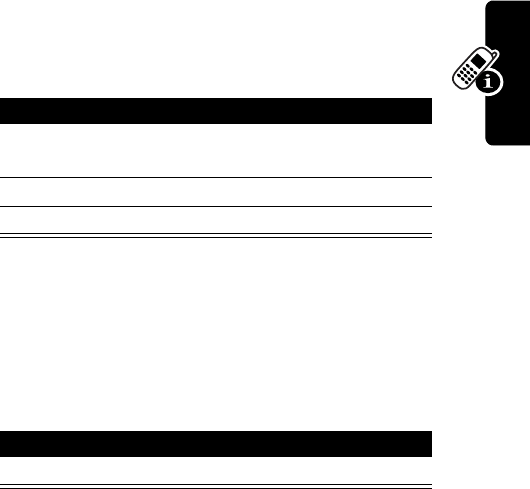
39
PRELIMINARY
Learning to Use Your Phone
If You Forget a Code or
Password
If you forget your security code (originally set to 000000),
SIM PIN, SIM PIN2, or call barring password, contact your
service provider.
If you forget your unlock code, try entering 1234 or the last
four digits of your phone number. If that does not work,
do the following when you see the
Enter Unlock Code
message:
Locking and Unlocking the
Keypad
You can lock the keypad to prevent accidental keypresses
(for example, when carrying your phone in a purse or
pocket).
Note:
Incoming calls and messages unlock the keypad.
Press To
1
M
go to the unlock code bypass
screen
2
keypad keys enter your security code
3
OK
(
+
) submit your security code
Press To
M*
lock or unlock your keypad
UG.C330.GSM.book Page 39 Wednesday, January 8, 2003 2:00 PM

40
PRELIMINARY
Setting Up Your Phone
Setting Up Your Phone
Storing Your Name and Phone
Number
To store or edit user name and phone number information
on your SIM card:
If you do not know your phone number, contact your
service provider. To view your phone number from the idle
display or during a call, see page 22.
Setting the Time and Date
To use the datebook, you must set the time and date:
Setting a Ring Style
Your phone rings or vibrates to notify you of an incoming
call, message, or other event. This ring or vibration is
called an alert.
You can select one of five different alert profiles:
Find the Feature
M
>
Settings
>
Phone Status
>
My Tel. Numbers
Find the Feature
M
>
Settings
>
Other Settings
>
Initial Setup
>
Time and Date
Y
Loud ring
X
Soft ring
UG.C330.GSM.book Page 40 Wednesday, January 8, 2003 2:00 PM
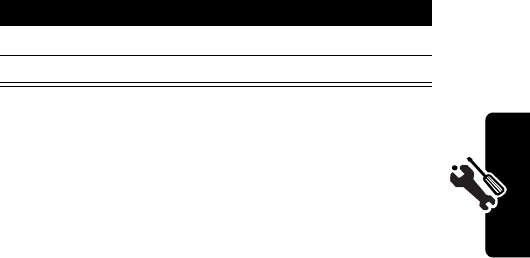
41
PRELIMINARY
Setting Up Your Phone
The alert indicator in your display shows the current alert
type (see the indicators on page 24).
To set an alert:
Each alert profile contains settings for specific event alerts
and ringer and keypad volume. To change these
settings:
Setting Answer Options
You can use different methods to answer an incoming call.
The
Answer Options
menu includes:
W
Vibrate
_
Vibrate and ring
a
Silent
Find the Feature
M
>
Ring Styles
>
Alert
Press To
1
S
scroll to the alert profile
2
SELECT
(
+
) select the alert profile
Find the Feature
M
>
Ring Styles
>alert
Detail
Find the Feature
M
>
Settings
>
In-Call Setup
>
Answer Options
Multi-Key
answer by pressing any key
UG.C330.GSM.book Page 41 Wednesday, January 8, 2003 2:00 PM
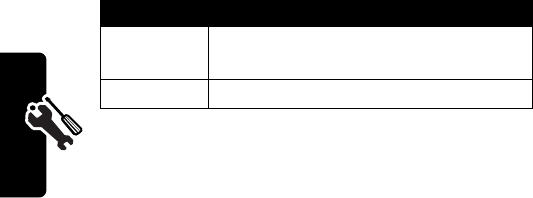
42
PRELIMINARY
Setting Up Your Phone
Setting a Wallpaper Image
You can set a picture or an animation as a wallpaper
(background) image in your phone’s idle display.
Note:
When you set an animation as a wallpaper image,
only the first frame of the animation is displayed.
Selecting a Screen Saver
You can set a picture or an animation as a screen saver
image. The image displays when the phone detects no
activity for a specified time.
The screen saver image is shrunk to fill the display, if
necessary. An animation repeats for one minute, then the
first frame of the animation displays.
Find the Feature
M
>
Settings
>
Other Settings
>
Personalize
>
Wallpaper
Setting Description
Picture
select the picture or animation for the
background image in your idle display
Layout
select
Center
or
Tile
Find the Feature
M
>
Settings
>
Other Settings
>
Personalize
>
Screen Saver
UG.C330.GSM.book Page 42 Wednesday, January 8, 2003 2:00 PM
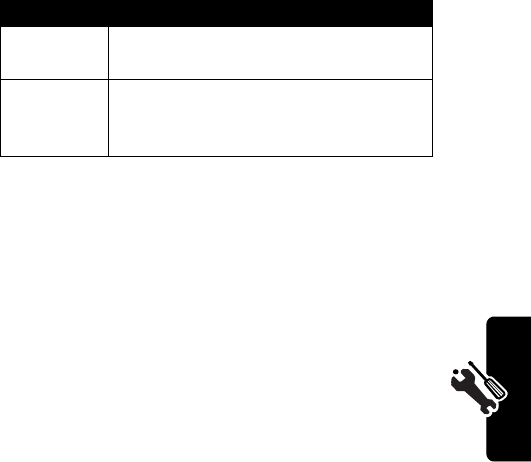
43
PRELIMINARY
Setting Up Your Phone
Zooming In and Out
Press and release
M
, then press and hold
M
to zoom in
and out on the display. Zoom in to increase text size, zoom
out to display more information.
You can also zoom in and out from the menu:
Setting Display Contrast
Setting Description
Picture
select the picture that appears when
your phone is idle
Delay
select how long your phone must be
idle before the screen saver picture
appears
Find the Feature
M
>
Settings
>
Other Settings
>
Initial Setup
>
Zoom
Find the Feature
M
>
Settings
>
Other Settings
>
Initial Setup
>
Contrast
UG.C330.GSM.book Page 43 Wednesday, January 8, 2003 2:00 PM
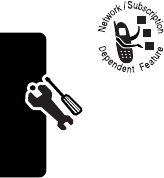
44
PRELIMINARY
Setting Up Your Phone
Adjusting the Backlight
You can set the amount of time that the display backlight
remains on, or turn off the backlight to conserve battery
power:
Conserving Battery Power
Some networks and phones include a
battery save setting to conserve battery
power.
Find the Feature
M
>
Settings
>
Other Settings
>
Initial Setup
>
Backlight
Find the Feature
M
>
Settings
>
Other Settings
>
Initial Setup
>
Battery Save
UG.C330.GSM.book Page 44 Wednesday, January 8, 2003 2:00 PM
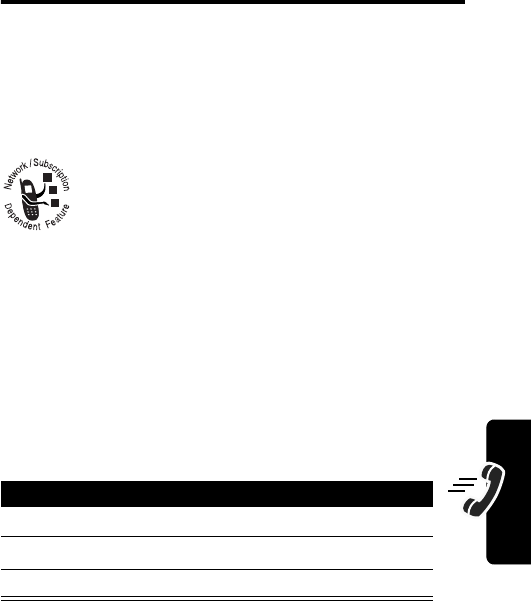
45
PRELIMINARY
Calling Features
Calling Features
For basic instructions on how to make and answer calls,
see page 21.
Changing the Active Line
Change the active phone line to make and
receive calls from your other phone number.
The active line indicator in the display shows the current
active phone line (see page 24).
Redialing a Number
From the idle display:
Using Automatic Redial
If you receive a busy signal, your phone displays
Call Failed
.
Find the Feature
M
>
Settings
>
Phone Status
>
Active Line
Press To
1
N
view the dialed calls list
2
S
scroll to the entry you want
3
N
redial the number
UG.C330.GSM.book Page 45 Wednesday, January 8, 2003 2:00 PM
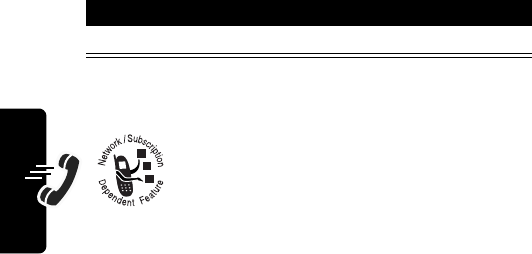
46
PRELIMINARY
Calling Features
With automatic redial, your phone automatically redials the
number. When the call goes through, your phone rings or
vibrates one time, displays
Redial Successful
, and then
connects the call.
You must turn on automatic redial to use the feature. To
turn automatic redial on or off:
When automatic redial is turned off, you can manually
activate the feature to redial a phone number. When you
hear a busy signal and see
Call Failed
:
Using Caller ID
Calling line identification (caller ID) displays
the phone number for incoming calls.
For
Incoming Calls:
The phone displays the
caller’s name when the name is stored in
your phonebook, or
Incoming Call
when caller ID
information is not available.
For
Outgoing Calls:
Other phones can display your phone
number when you call them or send a message. To hide
your number for the next call or message, press
M
>
Settings
>
In-Call Setup
>
My Caller ID
>
Next Call Only
.
Find the Feature
M
>
Settings
>
Other Settings
>
Initial Setup
>
Auto Redial
Press To
N
or
RETRY
(
+
) activate automatic redial
UG.C330.GSM.book Page 46 Wednesday, January 8, 2003 2:00 PM
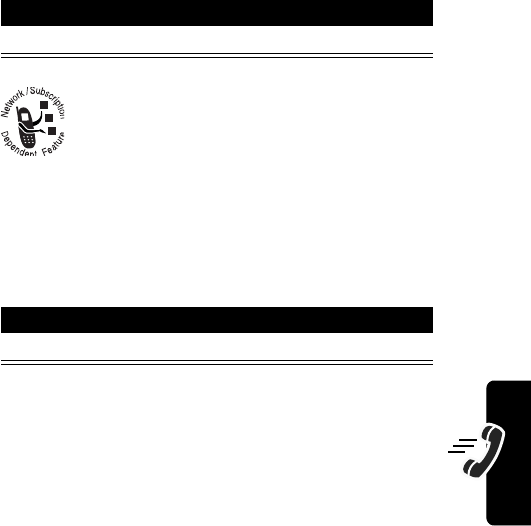
47
PRELIMINARY
Calling Features
Canceling an Incoming Call
While the phone is ringing or vibrating:
Depending on your phone settings and the type
of subscription you have, the call may be
forwarded to another number, or the caller may
hear a busy signal.
Turning Off a Call Alert
You can turn off your phone’s incoming call alert before
answering the call:
Calling an Emergency
Number
Your service provider programs one or more
emergency phone numbers (such as 112 or 911) that you
can call under any circumstances, even when your phone
is locked.
Note:
Emergency numbers vary by country. Your phone’s
emergency number(s) may not work in all locations, and
Press To
IGNORE
(
-
) cancel the incoming call
Press To
S
up or down turn off the alert
UG.C330.GSM.book Page 47 Wednesday, January 8, 2003 2:00 PM
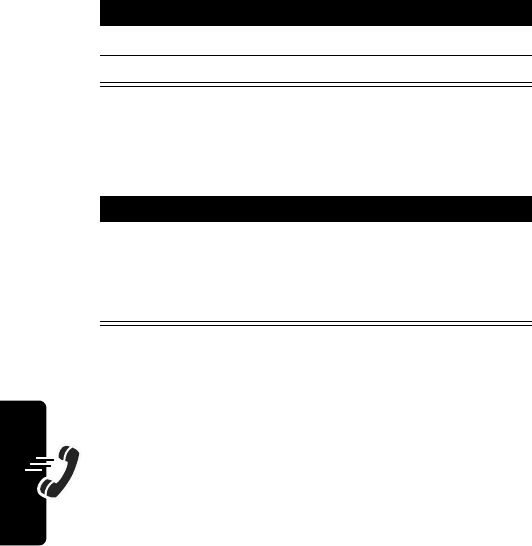
48
PRELIMINARY
Calling Features
sometimes an emergency call cannot be placed due to
network, environmental, or interference issues.
Dialing International Numbers
To dial the local international access code:
Viewing the Received Calls or
Dialed Calls List
Your phone keeps lists of the calls you recently
received and dialed, even if the calls did not connect.
The lists are sorted from newest to oldest, and contain
up to 10 entries. The oldest entries are deleted as new
ones are added.
Shortcut:
From the idle display, press
N
to go directly to
the dialed calls list.
Press To
1
keypad keys dial the emergency number
2
N
call the emergency number
Do This To
Press
0
for two
seconds
insert the international
access code (
+
) for the
country from which you are
dialing
Find the Feature
M
>
Recent Calls
UG.C330.GSM.book Page 48 Wednesday, January 8, 2003 2:00 PM
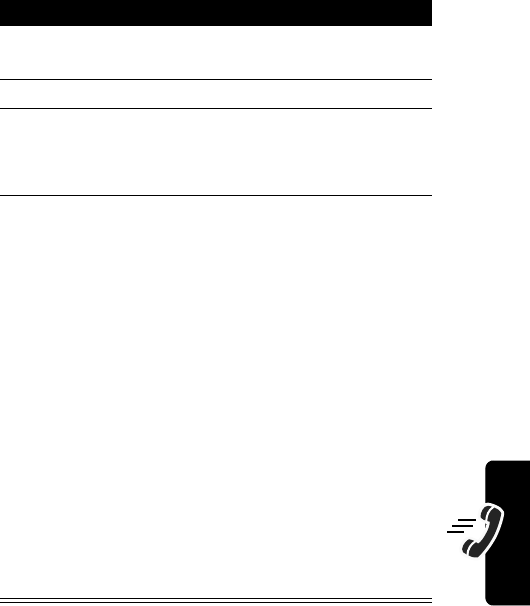
49
PRELIMINARY
Calling Features
Press To
1
S
scroll to
Received Calls
or
Dialed Calls
2
SELECT
(
+
) select the list
3
S
scroll to an entry
Note:
\
means the call
connected.
4
N
call the entry’s number
Note:
Press and hold
N
for
two seconds to send the
number as DTMF tones
during a call.
or
+
if
View
appears above the
+
key—view the entry’s details
if
Store
appears above the
+
key—store the entry’s
details in the phonebook
or
M
open the
Last Calls Menu
to
perform other procedures as
described in the following list
UG.C330.GSM.book Page 49 Wednesday, January 8, 2003 2:00 PM
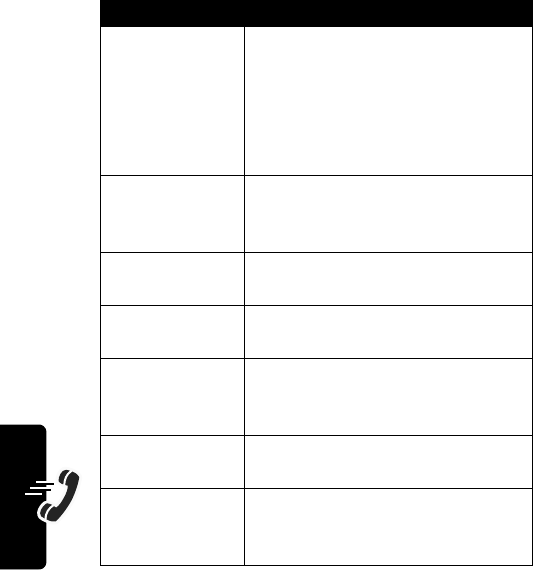
50
PRELIMINARY
Calling Features
The
Last Calls Menu
can include the following options:
Option Description
Store
Create a phonebook entry with
the selected number in the
No.
field. (This option does not appear
if
STORE
appears above the
+
key, or if the number is already
stored as a phonebook entry.)
Delete
Delete the entry. (This option
does not appear if
DELETE
appears
above the
+
key.)
Delete All
Delete all entries in the current
list.
Hide ID
/
Show ID
Hide (or show) your caller ID for
the next call.
Send Message
Create a new text message, with
the selected number in the
Tel No.
field. See page 9.
Add Digits
Add digits to the end of the
selected number.
Attach Number
Attach another number from the
phonebook or recent calls list to
the end of the selected number.
UG.C330.GSM.book Page 50 Wednesday, January 8, 2003 2:00 PM
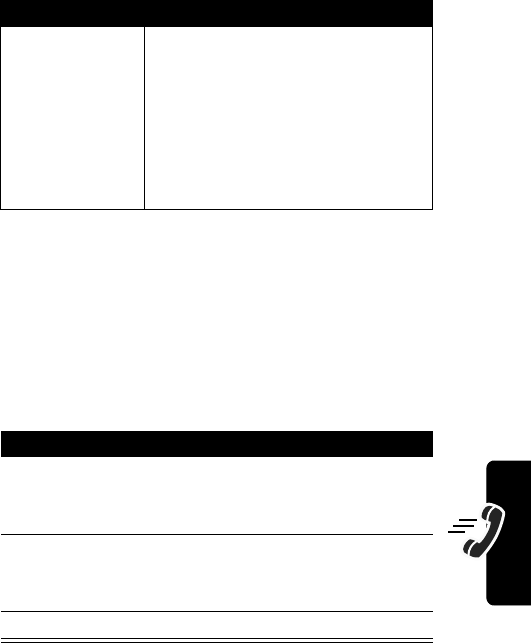
51
PRELIMINARY
Calling Features
Returning an Unanswered Call
Your phone keeps a record of your unanswered calls and
displays:
•
the
N
(missed call) indicator
•
X
Missed Calls
, where X is the total number of
missed calls
Using the Notepad
Your phone stores the most recent string of digits entered
on the keypad in a temporary memory location called the
Send Tones
Send the selected number to the
network as DTMF tones, for credit
card calling or password entry.
(This option is available only
during an active call.)
To activate DTMF tones, see
“Using DTMF Tones” on page 51.
Press To
1
VIEW
(
+
) see the received calls list,
beginning with the most
recent call
2
S
scroll through the list and
select a call that you want to
return
3
N
make the call
Option Description
UG.C330.GSM.book Page 51 Wednesday, January 8, 2003 2:00 PM
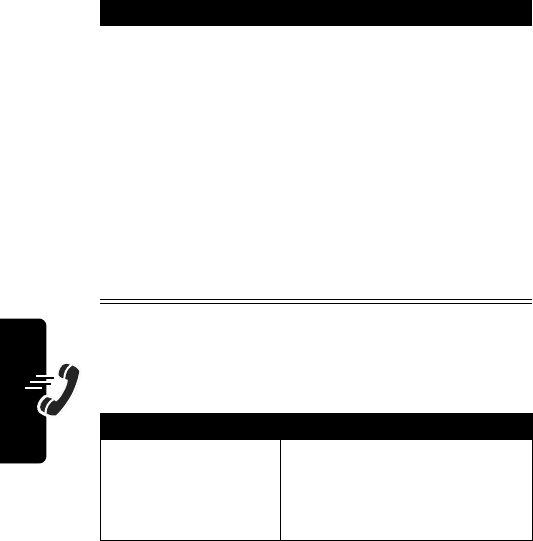
52
PRELIMINARY
Calling Features
notepad. This can be a phone number that you called, or a
number that you entered but did not call. To retrieve the
number stored in the notepad:
Attaching a Number
While dialing (with digits visible in the display):
Find the Feature
M
>
Recent Calls
>
Notepad
Press To
N
call the number
or
M
open the
Dialing Menu
to attach a
number or insert a special character .
or
STORE
(
+
) create a new phonebook entry, with
the notepad number copied into the
No.
field.
See “Creating a Phonebook Entry” on
page 24.
Do This To
Press
M
>
Attach Number
attach a number from the
phonebook or recent calls list
to the end of the digits you
entered
UG.C330.GSM.book Page 52 Wednesday, January 8, 2003 2:00 PM
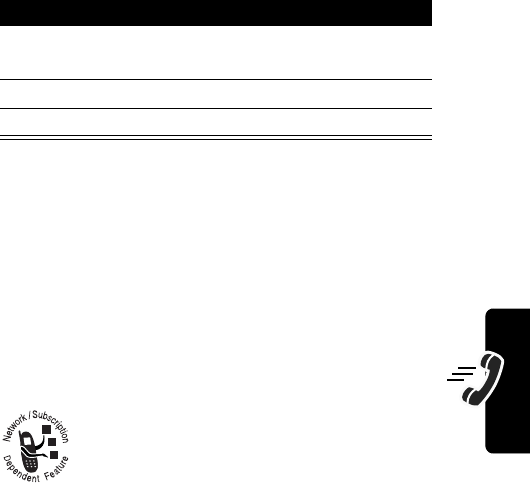
53
PRELIMINARY
Calling Features
Calling With Speed Dial
Each entry in your phonebook is assigned a unique speed
dial number that identifies the location where the entry is
stored in phone memory or on the SIM card. to speed dial
a phonebook entry, in the idle display:
Calling With 1-Touch Dial
To call phonebook entries 1 through 9, just press and hold
the one-digit speed dial number for one second.
Tip:
You must specify which phone number list you want to
use with this feature: phone memory phonebook, or SIM
card phonebook. See your Reference Guide.
Using Voicemail
You can listen to your voicemail messages
by calling your network voicemail phone
number. Voicemail messages are stored on the
network—not on your phone.
Press To
1
keypad keys enter the speed dial number
for the entry you want to dial
2
#
submit the number
3
N
call the entry
UG.C330.GSM.book Page 53 Wednesday, January 8, 2003 2:00 PM
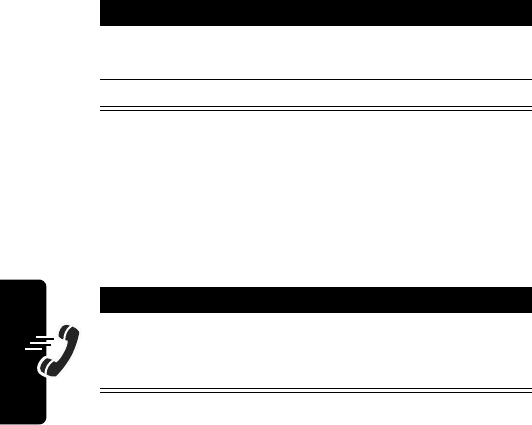
54
PRELIMINARY
Calling Features
Storing Your Voicemail Number
Store your voicemail number in your phone makes it easy
for you to listen to new voicemail messages. Your
voicemail number is provided by your service provider.
Receiving a New Voicemail Message
When you receive a voicemail message, your phone
displays
f
(voice message waiting) and
New VoiceMail
.
Some networks only indicate when you have messages,
whether they are new or not.
Listening to a Voicemail Message
Once you store your voicemail number, you can listen to
your voicemail messages at any time:
Find the Feature
M
>
Messages
M
>
VoiceMail Setup
Press To
1
keypad keys enter the phone number for
your voicemail
2
OK
(
+
) store the number
Press To
CALL
(
+
) call the voicemail phone
number you stored and listen
to the message
Find the Feature
M
>
Messages
>
VoiceMail
UG.C330.GSM.book Page 54 Wednesday, January 8, 2003 2:00 PM
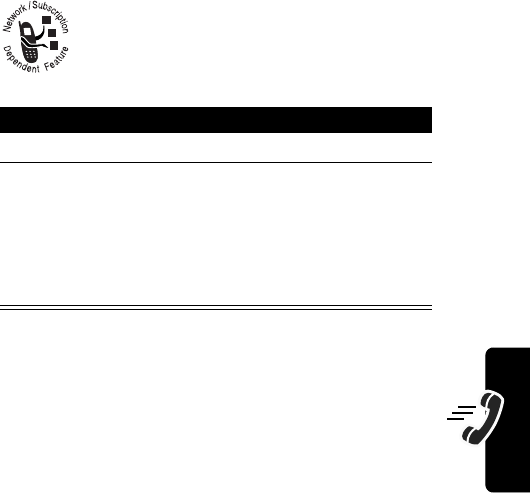
55
PRELIMINARY
Calling Features
Your phone calls your voicemail number. If no voicemail
number is stored, the phone prompts you to store one.
Using Call Waiting
When you are on a call, an alert tone sounds to
indicate that you have received a second call.
You must turn on call waiting to use this feature. To turn
call waiting on or off:
Press To
1
N
answer the new call
2
SWITCH
(
+
)
or
LINK
(
-
)
switch back to the first call
Note:
You can press
SWITCH
(
+
) at any time to
switch between calls.
connect the two calls
Find the Feature
M
>
Settings
>
In-Call Setup
>
Call Waiting
UG.C330.GSM.book Page 55 Wednesday, January 8, 2003 2:00 PM
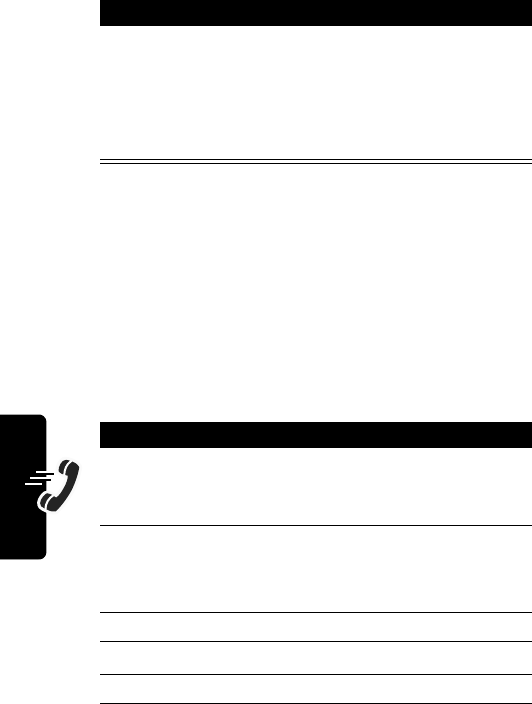
56
PRELIMINARY
Calling Features
Putting a Call on Hold
Transferring a Call
While you are on a call, you can transfer the call to another
phone by first talking to the person who answers the other
phone, or by directly transferring the call.
Announcing the Call Transfer
Press To
HOLD
(
+
) (if
available)
or
M
>
Hold
put a call on hold
Your phone displays a
=
(flashing phone) indicator to
indicate that the call is on
hold.
Find the Feature
M
>
Hold
Press To
1
keypad keys enter the phone number
where you are transferring
the call
2
N
dial the phone number
Speak to the person who
answers the target phone.
3
M
open the menu
4
S
scroll to
Transfer
5
SELECT
(
+
) select
Transfer
UG.C330.GSM.book Page 56 Wednesday, January 8, 2003 2:00 PM
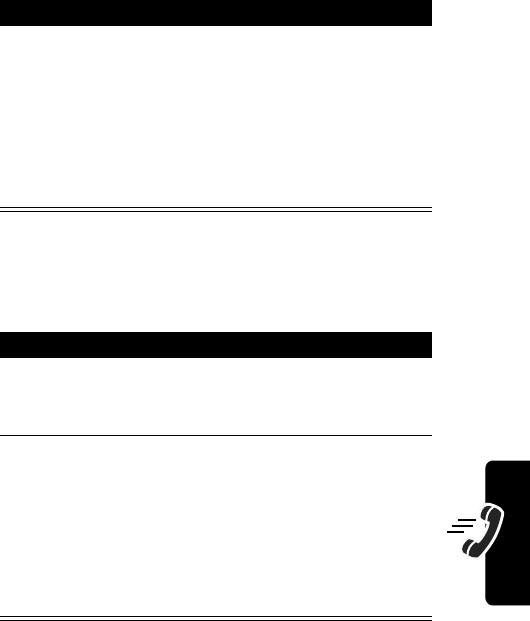
57
PRELIMINARY
Calling Features
Not Announcing the Call Transfer
6
OK
(
+
) confirm the transfer
Your phone displays the
message
Transfer: Complete
when
the call is transferred. You
can hang up the phone when
you see this message.
Find the Feature
M
>
Transfer
Press To
1
keypad keys enter the phone number
where you are transferring
the call
2
N
dial the phone number
Your phone displays the
message
Transfer: Complete
when
the call is transferred. You
can hang up the phone when
you see this message.
Press To
UG.C330.GSM.book Page 57 Wednesday, January 8, 2003 2:00 PM
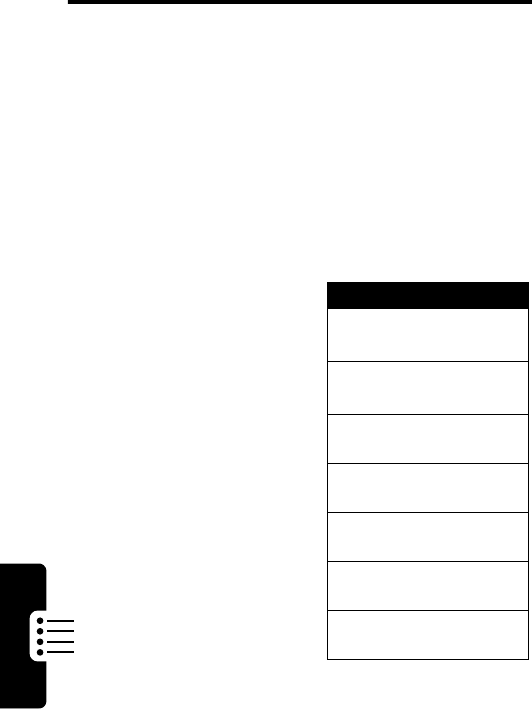
58
Phone Features
PRELIMINARY
Phone Features
Main Menu
This is the standard main menu layout.
Menu
organization and feature names may vary on your
phone.
Not all features may be available for all users.
•
m
Voice Dial
•
á
Recent Calls
•
o
Chat *
•
ç
Media Center
• My Tones
• MotoMixer
• Picture Viewer
•Themes
•
&
Ring Styles
•
-
Games and Apps
•
b
Browser *
• ??Office Tools
• Datebook
•Calculator
•
ã
Settings
• (see next page)
•
More
>
•
r
Phonebook
• ??Web Sessions *
•
U
Messages *
•
:
MyMenu
•
7
SIM Applications *
•
Q
Fixed Dial
•
R
Quick Dial
•
9
Service Dial *
•
* optional network,
SIM card, or
subscription-
dependent features
Shortcuts
O
pen
Phonebook
:
Press
S
d
or
e
in idle
Set ring volume
:
Press
S
b
or
c
in idle
Display my number:
Press
M#
in idle
View dialed calls list:
Press
N
in idle
Change display zoom:
Press
M
, then hold
M
Lock keypad:
Press
M*
Exit menu system:
Press
O
in a menu
See page 42 for MyMenu
Shortcuts
UG.C330.GSM.book Page 58 Wednesday, January 8, 2003 2:00 PM

59
PRELIMINARY
Phone Features
Settings Menu
• Call Forward *
• Voice Calls
• Data Calls
•Fax Calls
• Cancel All
• Forward Status
• Phone Status
•My Tel. Numbers
*
• Credit Info/Available
*
• Active Line
• Battery Meter
• Other Information
• In-Call Setup
• In-Call Timer
• Call Cost Setup
*
• My Caller ID
• Talk and Fax
*
• Answer Options
• Call Waiting
*
• Security
• Phone Lock
• Lock Keypad
• Lock Application
• Fixed Dial
• Call Barring
*
• SIM PIN
•New Passwords
• Other Settings
• Personalize
•Main Menu
•Keys
•Greeting
*
• Wallpaper
• Screen Saver
•Quick Dial
*
• Initial Setup
• Time and Date
• 1-Touch Dial
• Backlight
• TTY Setup
•Zoom
•Scroll
• Animation
• Language
• Battery Save
• Contrast
•DTMF
•Master Reset
• Master Clear
•Network
• Car Settings
• Headset
*
optional network, SIM
card, or subscription-
dependent features
UG.C330.GSM.book Page 59 Wednesday, January 8, 2003 2:00 PM
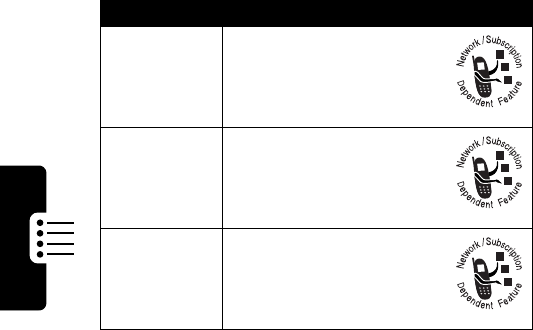
60
Phone Features
PRELIMINARY
Feature Quick Reference
You can do more with your phone than make and receive
phone calls! For example, you can:
•
store frequently called numbers in the phonebook for
easy dialing
•
organize your meetings and other events in the
datebook
•
browse the Web
•
download applications
•
send messages, and more.
This section provides information to help you use features
on your phone that are not described in this user guide.
For more detailed information, see the reference guide.
Calling Features
Feature Description
Conference
Call
During a call:
M
>
Hold
, dial next
number, press
N
, press
LINK
(
-
)
Call
Forwarding
Set up or cancel call
forwarding:
M
>
Settings
>
Call Forward
Call Barring
Restrict outgoing or
incoming calls:
M
>
Settings
>
Security
>
Call Barring
UG.C330.GSM.book Page 60 Wednesday, January 8, 2003 2:00 PM
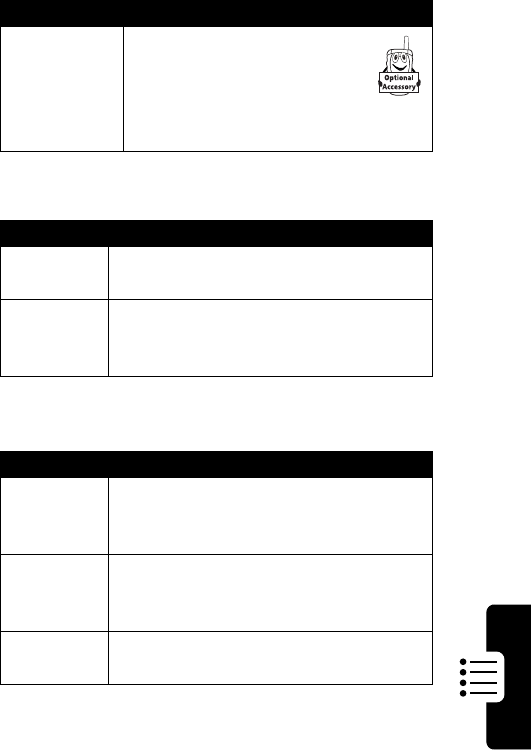
61
PRELIMINARY
Phone Features
Message Features
Chat Features
TTY Calls
Set up your phone for use
with an optional TTY device:
M
>
Settings
>
Other Settings
>
Initial Setup
>
TTY Setup
Feature Description
Send
Message
Send a text message:
M
>
Messages
>
Create Message
Receive
Message
Read a new text message that you
have received:
Press
READ
(
+
)
Feature Description
Start Chat
Start a new chat session:
M
>
Chat
M
>
New Chat
Receive
Chat
Request
When you receive a chat request:
Press
ACCEPT
(
+
) or
IGNORE
(
-
)
End Chat
During a chat session:
M
>
End Chat
Feature Description
UG.C330.GSM.book Page 61 Wednesday, January 8, 2003 2:00 PM
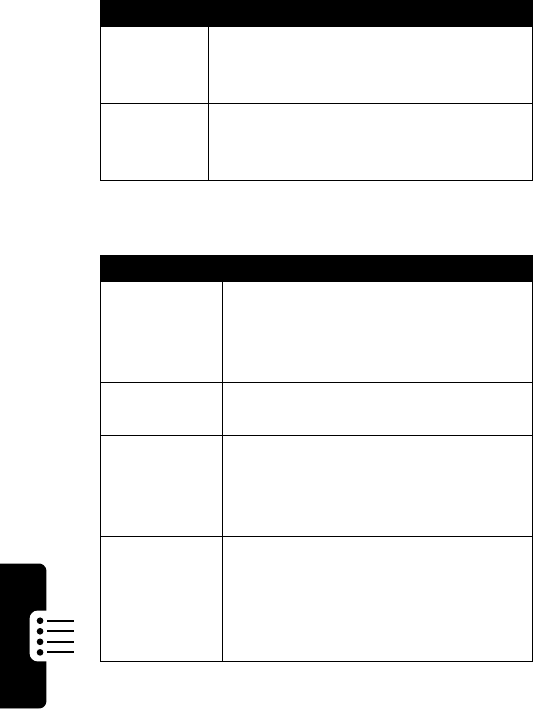
62
Phone Features
PRELIMINARY
Email Features
Phonebook Features
Feature Description
Send
Email
Message
Send an email message:
M
>
Messages
>
Email Messages
M
>
Create Email
Receive
Email
Message
Read a new email message that you
have received:
Press
READ
(
+
)
Feature Description
Create Entry
Create a new phonebook entry:
M
>
Phonebook
M
>
New
>
Phone Number
or
Email Address
Dial Number
Call a number in the phonebook:
M
>
Phonebook
> entry to call
Voice Dial
Number
Voice dial a number in the
phonebook:
Press and release the voice key, and
say the entry’s name (in 2 seconds)
1-Touch
Dial
Set 1-touch dial to call entries stored
in your phone memory phonebook or
the SIM card phonebook:
M
>
Settings
>
Other Settings
>
Initial Setup
>
1-Touch Dial
UG.C330.GSM.book Page 62 Wednesday, January 8, 2003 2:00 PM
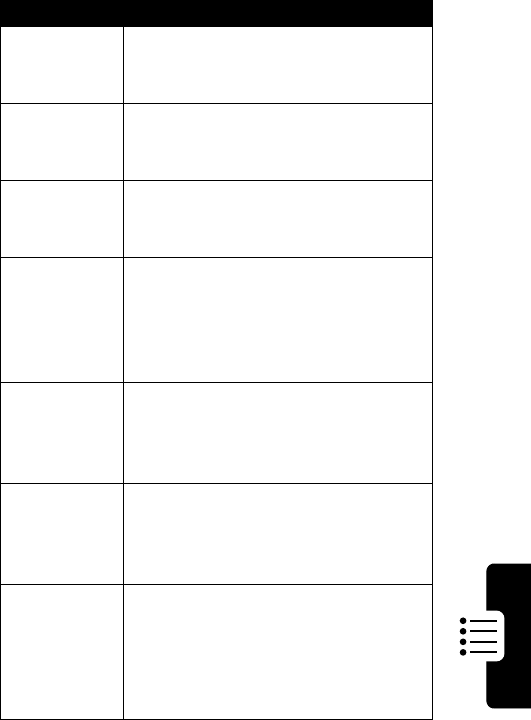
63
PRELIMINARY
Phone Features
Personalizing Features
Feature Description
Event Alert
Change an event alert:
M
>
Settings
>
Ring Styles
>Style
Detail
> event name
Ring
Volume
Adjust ringer volume:
M
>
Settings
>
Ring Styles
>Style
Detail
>
Ring Volume
Keypad
Volume
Adjust keypad keypress volume:
M
>
Settings
>
Ring Styles
>Style
Detail
>
Key Volume
My Tones
Compose your own ring tones,
manage ring tones that you have
composed or downloaded:
M
>
Settings
>
Ring Styles
>
My Tones
Themes
Apply the wallpaper, screen saver,
ring style, and other settings in a
theme
M
>
Media Center
>
Themes
Soft Keys
Change soft key labels in the idle
display:
M
>
Settings
>
Other Settings
>
Personalize
>
Keys
Shortcuts
Create a shortcut to a menu item:
Highlight the menu item, then press
and hold
M
Select a shortcut:
M
>
Shortcuts
> shortcut name
UG.C330.GSM.book Page 63 Wednesday, January 8, 2003 2:00 PM
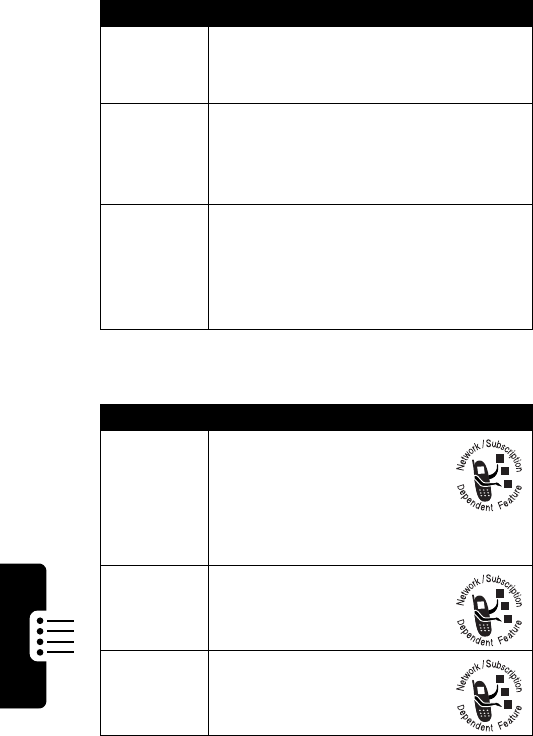
64
Phone Features
PRELIMINARY
Menu Features
Dialing Features
Feature Description
Language
Set menu language:
M
>
Settings
>
Other Settings
>
Initial Setup
>
Language
Master
Reset
Reset all options except unlock code,
security code, lifetime timer:
M
>
Settings
>
Other Settings
>
Initial Setup
>
Master Reset
Master
Clear
Reset all options except unlock code,
security code, lifetime timer, clear all
user settings and entries:
M
>
Settings
>
Other Settings
>
Initial Setup
>
Master Clear
Feature Description
Fixed Dial
Turn fixed dialing on or off:
M
>
Settings
>
Security
>
Fixed Dial
Use the fixed dial list:
M
>
Fixed Dial
Service
Dial
Dial service phone
numbers:
M
>
Service Dial
Quick Dial
Dial pre-programmed phone
numbers:
M
>
Quick Dial
UG.C330.GSM.book Page 64 Wednesday, January 8, 2003 2:00 PM
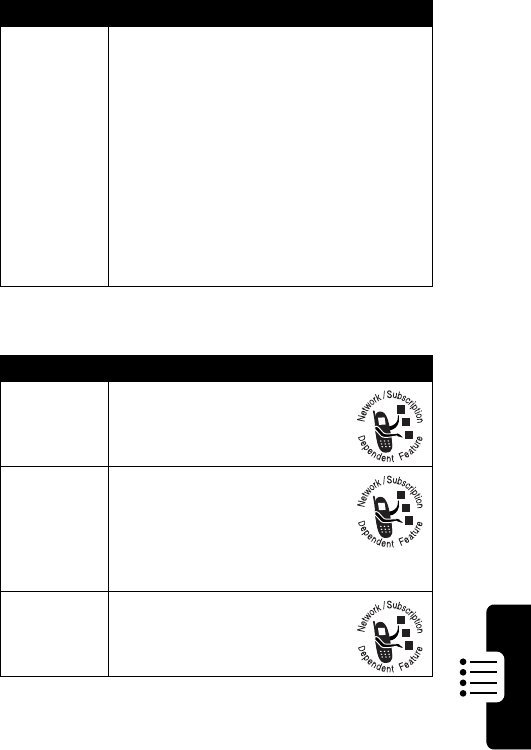
65
PRELIMINARY
Phone Features
Call Monitoring Features
DTMF
Tones
Activate DTMF tones:
M
>
Settings
>
Other Settings
>
Initial Setup
>
DTMF
Send DTMF tones during a call:
Press number keys
Send stored numbers as DTMF tones
during a call:
Highlight a number in the phonebook
or recent call lists, then press
M
>
Send Tones
Feature Description
Call Times
View call timers:
M
>
Recent Calls
>
Call Times
In-Call
Timer
Display time or cost
information during a call:
M
>
Settings
>
In-Call Setup
>
In-Call Timer
Call Cost
View call cost trackers:
M
>
Recent Calls
>
Call Cost
Feature Description
UG.C330.GSM.book Page 65 Wednesday, January 8, 2003 2:00 PM
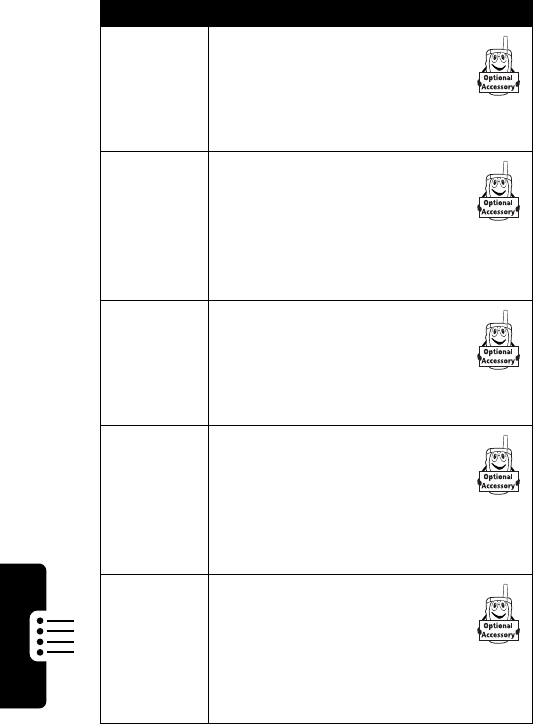
66
Phone Features
PRELIMINARY
Hands-Free Features
Feature Description
Speaker-
phone
Activate a connected external
speakerphone during a call:
Press
SPEAKER
(
+
)
(if available) or
M
>
Spkrphone On
Auto
Answer
(car kit or
headset)
Automatically answer calls
when connected to a car kit or
headset:
M
>
Settings
>
Other Settings
>
Car Settings
or
Headset
>
Auto Answer
Auto
Hands-
Free
(car kit)
Automatically route calls to a
car kit when connected:
M
>
Settings
>
Other Settings
>
Car Settings
>
Auto Handsfree
Power-Off
Delay
(car kit)
Set the phone to stay on for a
period of time after the ignition
is switched off:
M
>
Settings
>
Other Settings
>
Car Settings
>
Power-Off Delay
Charger
Time
(car kit)
Charge the phone for a period
of time after the ignition is
switched off:
M
>
Settings
>
Other Settings
>
Car Settings
>
Charger Time
UG.C330.GSM.book Page 66 Wednesday, January 8, 2003 2:00 PM
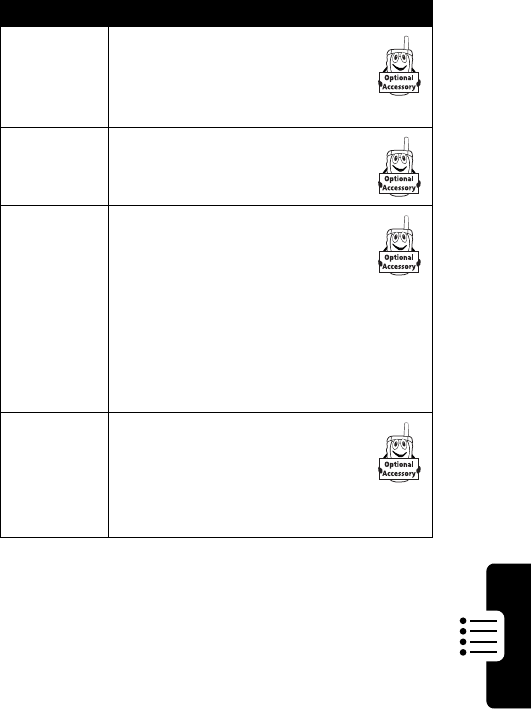
67
PRELIMINARY
Phone Features
Data and Fax Call Features
Feature Description
IrDA Link
Set up an infrared connection
with an external device:
M
>
Settings
>
Connection
>
IrDA Link
Send Data
or Fax
Connect your phone to the
device, then place the call
through the device application
Receive
Data or
Fax
Connect your phone to the
device, then:
M
>
Settings
>
Connection
>
Incoming Call
>
Next Call
>
Data In Only
or
Fax In Only
Reset normal voice operation:
M
>
Settings
>
Connection
>
Incoming Call
>
Next Call
>
Normal
Talk Then
Fax
Connect your phone to the
device, enter the number,
press
M
>
Dialing Menu
>
Talk Then Fax
, then press
N
to make the call
UG.C330.GSM.book Page 67 Wednesday, January 8, 2003 2:00 PM
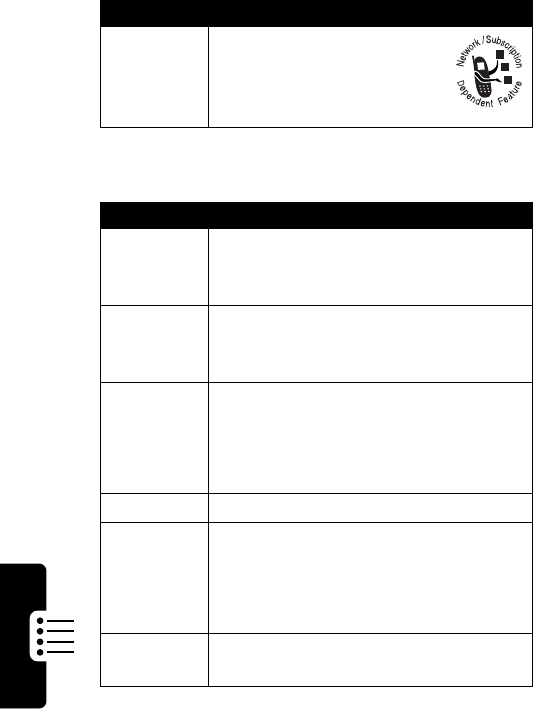
68
Phone Features
PRELIMINARY
Network Features
Personal Organizer Features
Feature Description
Network
Settings
View network information
and adjust network settings:
M
>
Settings
>
Other Settings
>
Network
Feature Description
Add
Datebook
Event
Add an event to the datebook:
M
>
Datebook
> day
M
>
New
View
Datebook
Event
View or edit event details:
M
>
Datebook
> day > event name
Event
Reminder
View event reminder:
VIEW
(
+
)
Dismiss event reminder:
EXIT
(
-
)
Set Alarm
M
>
Alarm Clock
>
[New Alarm]
Turn Off
Alarm
Turn off alarm:
Press
DISABLE
(
-
) or
O
Set 8-minute delay:
Press
SNOOZE
(
+
)
Calculator
Calculate numbers:
M
>
Calculator
UG.C330.GSM.book Page 68 Wednesday, January 8, 2003 2:00 PM
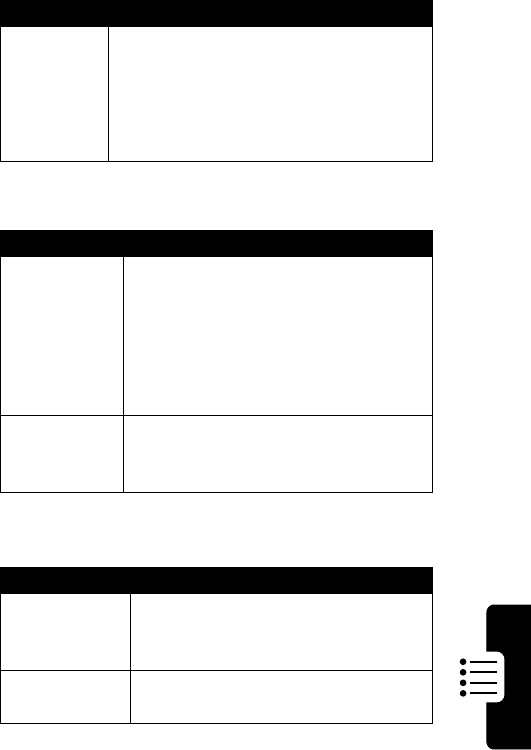
69
PRELIMINARY
Phone Features
Security Features
News and Entertainment Features
Currency
Converter
Convert currency:
M
>
Calculator
M
>
Exchange Rate
Enter exchange rate, press
OK
(
+
),
enter amount, select
$
function
Feature Description
SIM PIN
Lock or unlock the SIM card:
M
>
Settings
>
Security
>
SIM PIN
Caution:
If you enter an incorrect
PIN code three times in a row, your
SIM card is disabled and your phone
displays
SIM Blocked
.
Lock
Application
Lock phone applications:
M
>
Settings
>
Security
>
Lock Application
Feature Description
Launch
Micro-
Browser
Start a micro-browser session:
M
>
Browser
Web
Sessions
Select or create a Web session:
M
>
Web Sessions
Feature Description
UG.C330.GSM.book Page 69 Wednesday, January 8, 2003 2:00 PM
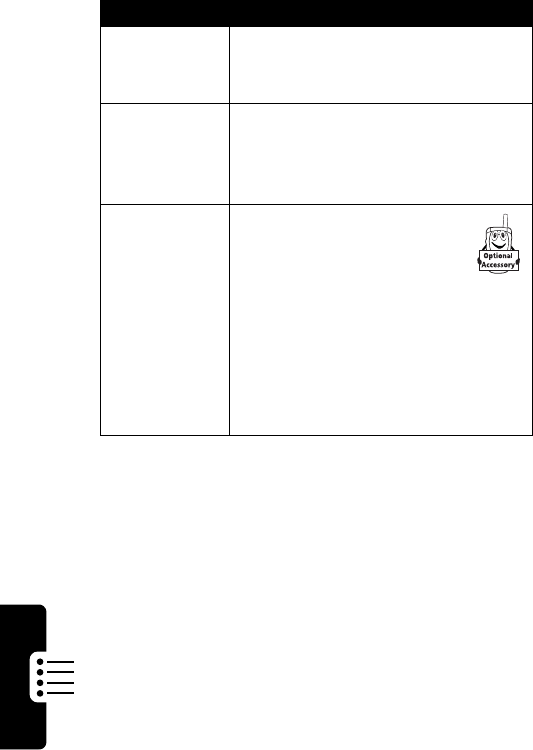
70
Phone Features
PRELIMINARY
Launch
Game or
Application
Launch a game or application:
M
>
Games and Apps
, highlight the
application, press
SELECT
(
+
)
Download
Game or
Application
Download a game or application:
M
>
Browser
, find the application,
press
SELECT
(
+
), press
DWNLOAD
(
+
)
Radio
Use the optional Motorola
Original™ FM Stereo Radio
Headset accessory:
M
>
Radio
Note:
This feature is available only
when the optional FM Stereo Radio
Headset accessory is plugged into
your phone (see phone illustration,
page 1).
Feature Description
UG.C330.GSM.book Page 70 Wednesday, January 8, 2003 2:00 PM

71
PRELIMINARY
Specific Absorption
Rate Data
The Motorola C350 Series wireless phone meets the
government’s requirements for exposure to radio waves.
Your wireless phone is a radio transmitter and receiver. It is designed and
manufactured not to exceed limits for exposure to radio frequency (RF)
energy set by the Federal Communications Commission (FCC) of the U.S.
Government and by Health Canada for Canada. These limits are part of
comprehensive guidelines and establish permitted levels of RF energy for
the general population. The guidelines are based on standards that were
developed by independent scientific organizations through periodic and
thorough evaluation of scientific studies. The standards include a
substantial safety margin designed to assure the safety of all persons,
regardless of age or health.
The exposure standard for wireless mobile phones employs a unit of
measurement known as the Specific Absorption Rate, or SAR. The SAR
limit set by the FCC and by Health Canada is 1.6 W/kg.
1
Tests for SAR
are conducted using standard operating positions accepted by the FCC
and by Industry Canada with the phone transmitting at its highest certified
power level in all tested frequency bands. Although the SAR is
determined at the highest certified power level, the actual SAR level of the
phone while operating can be well below the maximum value. This is
because the phone is designed to operate at multiple power levels so as
to use only the power required to reach the network. In general, the closer
you are to a wireless base station, the lower the power output.
Before a phone model is available for sale to the public in the U.S. and
Canada, it must be tested and certified to the FCC and Industry Canada
that it does not exceed the limit established by each government for safe
exposure. The tests are performed in positions and locations (e.g., at the
ear and worn on the body) reported to the FCC and available for review by
UG.C330.GSM.book Page 71 Wednesday, January 8, 2003 2:00 PM
72
PRELIMINARY
Industry Canada. The highest SAR value for this model phone when
tested for use at the ear is 0.93 W/kg, and when worn on the body, as
described in this user guide, is 0.39 W/kg. (Body-worn measurements
differ among phone models, depending upon available accessories and
regulatory requirements).
2
While there may be differences between the SAR levels of various phones
and at various positions, they all meet the governmental requirements for
safe exposure.
Additional information on Specific Absorption Rates (SAR) can be found
on the Cellular Telecommunications & Internet Association (CTIA) Web
site:
http://phonefacts.net
or the Canadian Wireless Telecommunications Association (CWTA) Web
site:
http://www.cwta.ca
1. In the United States and Canada, the SAR limit for mobile phones used by
the public is 1.6 watts/kg (W/kg) averaged over one gram of tissue. The
standard incorporates a substantial margin of safety to give additional
protection for the public and to account for any variations in measurements.
2. The SAR information includes the Motorola testing protocol, assessment
procedure, and measurement uncertainty range for this product.
UG.C330.GSM.book Page 72 Wednesday, January 8, 2003 2:00 PM

73
PRELIMINARY
The U.S. Food and Drug
Administration's Center
for Devices and Radiological
Health Consumer Update on
Mobile Phones
Additional Health and Safety Information
FDA has been receiving inquiries about the safety of mobile phones,
including cellular phones and PCS phones. The following summarizes
what is known—and what remains unknown—about whether these
products can pose a hazard to health, and what can be done to minimize
any potential risk. This information may be used to respond to questions.
Why the concern?
Mobile phones emit low levels of radio frequency energy (i.e., radio
frequency radiation) in the microwave range while being used. They also
emit very low levels of radio frequency energy (RF), considered non-
significant, when in the stand-by mode. It is well known that high levels of
RF can produce biological damage through heating effects (this is how
your microwave oven is able to cook food). However, it is not known
whether, to what extent, or through what mechanism, lower levels of RF
might cause adverse health effects as well. Although some research has
been done to address these questions, no clear picture of the biological
effects of this type of radiation has emerged to date. Thus, the available
science does not allow us to conclude that mobile phones are absolutely
safe, or that they are unsafe. However, the available scientific evidence
does not demonstrate any adverse health effects associated with the use
of mobile phones.
What kinds of phones are in question?
Questions have been raised about hand-held mobile phones, the kind that
have a built-in antenna that is positioned close to the user's head during
normal telephone conversation. These types of mobile phones are of
UG.C330.GSM.book Page 73 Wednesday, January 8, 2003 2:00 PM
74
PRELIMINARY
concern because of the short distance between the phone's antenna—
the primary source of the RF—and the person's head. The exposure to
RF from mobile phones in which the antenna is located at greater
distances from the user (on the outside of a car, for example) is drastically
lower than that from hand-held phones, because a person's RF exposure
decreases rapidly with distance from the source. The safety of so-called
“cordless phones,” which have a base unit connected to the telephone
wiring in a house and which operate at far lower power levels and
frequencies, has not been questioned.
How much evidence is there that hand-held
mobile phones might be harmful?
Briefly, there is not enough evidence to know for sure, either way;
however, research efforts are on-going. The existing scientific evidence is
conflicting and many of the studies that have been done to date have
suffered from flaws in their research methods. Animal experiments
investigating the effects of RF exposures characteristic of mobile phones
have yielded conflicting results. A few animal studies, however, have
suggested that low levels of RF could accelerate the development of
cancer in laboratory animals. In one study, mice genetically altered to be
predisposed to developing one type of cancer developed more than twice
as many such cancers when they were exposed to RF energy compared
to controls. There is much uncertainty among scientists about whether
results obtained from animal studies apply to the use of mobile phones.
First, it is uncertain how to apply the results obtained in rats and mice to
humans. Second, many of the studies that showed increased tumor
development used animals that had already been treated with cancer-
causing chemicals, and other studies exposed the animals to the RF
virtually continuously—up to 22 hours per day.
For the past five years in the United States, the mobile phone industry has
supported research into the safety of mobile phones. This research has
resulted in two findings in particular that merit additional study:
1 In a hospital-based, case-control study, researchers looked for an
association between mobile phone use and either glioma (a type of
UG.C330.GSM.book Page 74 Wednesday, January 8, 2003 2:00 PM
75
PRELIMINARY
brain cancer) or acoustic neuroma (a benign tumor of the nerve
sheath). No statistically significant association was found between
mobile phone use and acoustic neuroma. There was also no
association between mobile phone use and gliomas when all types of
types of gliomas were considered together. It should be noted that
the average length of mobile phone exposure in this study was less
than three years.
When 20 types of glioma were considered separately, however, an
association was found between mobile phone use and one rare type
of glioma, neuroepithelliomatous tumors. It is possible with multiple
comparisons of the same sample that this association occurred by
chance. Moreover, the risk did not increase with how often the mobile
phone was used, or the length of the calls. In fact, the risk actually
decreased with cumulative hours of mobile phone use. Most cancer
causing agents increase risk with increased exposure. An ongoing
study of brain cancers by the National Cancer Institute is expected to
bear on the accuracy and repeatability of these results.
1
2 Researchers conducted a large battery of laboratory tests to assess
the effects of exposure to mobile phone RF on genetic material.
These included tests for several kinds of abnormalities, including
mutations, chromosomal aberrations, DNA strand breaks, and
structural changes in the genetic material of blood cells called
lymphocytes. None of the tests showed any effect of the RF except
for the micronucleus assay, which detects structural effects on the
genetic material. The cells in this assay showed changes after
exposure to simulated cell phone radiation, but only after 24 hours of
exposure. It is possible that exposing the test cells to radiation for this
long resulted in heating. Since this assay is known to be sensitive to
heating, heat alone could have caused the abnormalities to occur.
The data already in the literature on the response of the micronucleus
assay to RF are conflicting. Thus, follow-up research is necessary.
2
FDA is currently working with government, industry, and academic groups
to ensure the proper follow-up to these industry-funded research findings.
Collaboration with the Cellular Telecommunications Industry Association
UG.C330.GSM.book Page 75 Wednesday, January 8, 2003 2:00 PM
76
PRELIMINARY
(CTIA) in particular is expected to lead to FDA providing research
recommendations and scientific oversight of new CTIA-funded research
based on such recommendations.
Two other studies of interest have been reported recently in the literature:
1 Two groups of 18 people were exposed to simulated mobile phone
signals under laboratory conditions while they performed cognitive
function tests. There were no changes in the subjects' ability to recall
words, numbers, or pictures, or in their spatial memory, but they were
able to make choices more quickly in one visual test when they were
exposed to simulated mobile phone signals. This was the only
change noted among more than 20 variables compared.
3
2 In a study of 209 brain tumor cases and 425 matched controls, there
was no increased risk of brain tumors associated with mobile phone
use. When tumors did exist in certain locations, however, they were
more likely to be on the side of the head where the mobile phone was
used.
Because this occurred in only a small number of cases, the increased
likelihood was too small to be statistically significant.
4
In summary, we do not have enough information at this point to assure the
public that there are, or are not, any low incident health problems
associated with use of mobile phones. FDA continues to work with all
parties, including other federal agencies and industry, to assure that
research is undertaken to provide the necessary answers to the
outstanding questions about the safety of mobile phones.
What is known about cases of human cancer
that have been reported in users of hand-held
mobile phones?
Some people who have used mobile phones have been diagnosed with
brain cancer. But it is important to understand that this type of cancer also
occurs among people who have not used mobile phones. In fact, brain
cancer occurs in the U.S. population at a rate of about 6 new cases per
UG.C330.GSM.book Page 76 Wednesday, January 8, 2003 2:00 PM
77
PRELIMINARY
100,000 people each year. At that rate, assuming 80 million users of
mobile phones (a number increasing at a rate of about 1 million per
month), about 4800 cases of brain cancer would be expected each year
among those 80 million people, whether or not they used their phones.
Thus it is not possible to tell whether any individual's cancer arose
because of the phone, or whether it would have happened anyway. A key
question is whether the risk of getting a particular form of cancer is
greater among people who use mobile phones than among the rest of the
population. One way to answer that question is to compare the usage of
mobile phones among people with brain cancer with the use of mobile
phones among appropriately matched people without brain cancer. This
is called a case-control study. The current case-control study of brain
cancers by the National Cancer Institute, as well as the follow-up research
to be sponsored by industry, will begin to generate this type of
information.
What is FDA's role concerning the safety of
mobile phones?
Under the law, FDA does not review the safety of radiation-emitting
consumer products such as mobile phones before marketing, as it does
with new drugs or medical devices. However, the agency has authority to
take action if mobile phones are shown to emit radiation at a level that is
hazardous to the user. In such a case, FDA could require the
manufacturers of mobile phones to notify users of the health hazard and
to repair, replace or recall the phones so that the hazard no longer exists.
Although the existing scientific data do not justify FDA regulatory actions
at this time, FDA has urged the mobile phone industry to take a number of
steps to assure public safety. The agency has recommended that the
industry:
•
support needed research into possible biological effects of RF of the
type emitted by mobile phones
•
design mobile phones in a way that minimizes any RF exposure to
the user that is not necessary for device function
UG.C330.GSM.book Page 77 Wednesday, January 8, 2003 2:00 PM
78
PRELIMINARY
•
cooperate in providing mobile phone users with the best possible
information on what is known about possible effects of mobile phone
use on human health
At the same time, FDA belongs to an interagency working group of the
federal agencies that have responsibility for different aspects of mobile
phone safety to ensure a coordinated effort at the federal level. These
agencies are:
•
National Institute for Occupational Safety and Health
•
Environmental Protection Agency
•
Federal Communications Commission
•
Occupational Health and Safety Administration
•
National Telecommunications and Information Administration
The National Institutes of Health also participates in this group.
In the absence of conclusive information about
any possible risk, what can concerned
individuals do?
If there is a risk from these products—and at this point we do not know
that there is—it is probably very small. But if people are concerned about
avoiding even potential risks, there are simple steps they can take to do
so. For example, time is a key factor in how much exposure a person
receives. Those persons who spend long periods of time on their hand-
held mobile phones could consider holding lengthy conversations on
conventional phones and reserving the hand-held models for shorter
conversations or for situations when other types of phones are not
available.
People who must conduct extended conversations in their cars every day
could switch to a type of mobile phone that places more distance between
their bodies and the source of the RF, since the exposure level drops off
dramatically with distance. For example, they could switch to:
•
a mobile phone in which the antenna is located outside the vehicle
UG.C330.GSM.book Page 78 Wednesday, January 8, 2003 2:00 PM
79
PRELIMINARY
•
a hand-held phone with a built-in antenna connected to a different
antenna mounted on the outside of the car or built into a separate
package
•
a headset with a remote antenna to a mobile phone carried at the
waist
Again, the scientific data do not demonstrate that mobile phones are
harmful. But if people are concerned about the radio frequency energy
from these products, taking the simple precautions outlined above can
reduce any possible risk.
Where can I find additional information?
For additional information, see the following Web sites:
Federal Communications Commission
(FCC) RF Safety Program
(select “Information on Human Exposure to RF Fields from Cellular and
PCS Radio Transmitters”):
http://www.fcc.gov/oet/rfsafety
World Health Organization
(WHO) International Commission on
Non-Ionizing Radiation Protection (select Qs & As):
http://
www.who.int/emf
United Kingdom, National Radiological Protection Board
:
http://www.nrpb.org.uk
Cellular Telecommunications Industry Association
(CTIA):
http://www.wow-com.com
U.S. Food and Drug Administration
(FDA) Center for Devices and
Radiological Health:
http://www.fda.gov/cdrh/consumer/
1. Muscat et al. Epidemiological Study of Cellular Telephone Use and Malignant
Brain Tumors. In: State of the Science Symposium;1999 June 20; Long
Beach, California.
2. Tice et al. Tests of mobile phone signals for activity in genotoxicity and other
laboratory assays. In: Annual Meeting of the Environmental Mutagen Society;
UG.C330.GSM.book Page 79 Wednesday, January 8, 2003 2:00 PM
80
PRELIMINARY
March 29, 1999, Washington, D.C.; and personal communication,
unpublished results.
3. Preece, AW, Iwi, G, Davies-Smith, A, Wesnes, K, Butler, S, Lim, E, and Varey,
A. Effect of a 915-MHz simulated mobile phone signal on cognitive function
in man. Int. J. Radiat. Biol., April 8, 1999.
4. Hardell, L, Nasman, A, Pahlson, A, Hallquist, A and Mild, KH. Use of cellular
telephones and the risk for brain tumors: a case-control study. Int. J. Oncol.,
15: 113-116, 1999.
UG.C330.GSM.book Page 80 Wednesday, January 8, 2003 2:00 PM

81
PRELIMINARY
Motorola Limited Warranty for
the United States and Canada
Warranty
What Does this Warranty Cover?
Subject to the exclusions contained below, Motorola, Inc. warrants its
telephones, pagers, messaging devices, and consumer and professional
two-way radios (excluding commercial, government or industrial radios)
that operate via Family Radio Service or General Mobile Radio Service,
Motorola-branded or certified accessories sold for use with these
Products (“Accessories”) and Motorola software contained on CD-ROMs
or other tangible media and sold for use with these Products (“Software”)
to be free from defects in materials and workmanship under normal
consumer usage for the period(s) outlined below. This limited warranty is
a consumer's exclusive remedy, and applies as follows to new Motorola
Products, Accessories and Software purchased by consumers in the
United States or Canada, which are accompanied by this written
warranty:
Products and Accessories
Products Covered Length of Coverage
Products and Accessories
as
defined above, unless otherwise
provided for below.
One (1) year
from the date of
purchase by the first consumer
purchaser of the product unless
otherwise provided for below.
Decorative Accessories and
Cases
. Decorative covers,
bezels, PhoneWrap™ covers
and cases.
Limited lifetime warranty
for the
lifetime of ownership by the first
consumer purchaser of the
product.
UG.C330.GSM.book Page 81 Wednesday, January 8, 2003 2:00 PM

82
PRELIMINARY
Exclusions
Normal Wear and Tear.
Periodic maintenance, repair and replacement of
parts due to normal wear and tear are excluded from coverage.
Batteries.
Only batteries whose fully charged capacity falls below 80% of
their rated capacity and batteries that leak are covered by this limited
warranty.
Abuse & Misuse.
Defects or damage that result from: (a) improper
operation, storage, misuse or abuse, accident or neglect, such as physical
damage (cracks, scratches, etc.) to the surface of the product resulting
from misuse; (b) contact with liquid, water, rain, extreme humidity or
heavy perspiration, sand, dirt or the like, extreme heat, or food; (c) use of
the Products or Accessories for commercial purposes or subjecting the
Product or Accessory to abnormal usage or conditions; or (d) other acts
which are not the fault of Motorola, are excluded from coverage.
Use of Non-Motorola Products and Accessories.
Defects or damage
that result from the use of Non-Motorola branded or certified Products,
Accessories, Software or other peripheral equipment are excluded from
coverage.
Monaural Headsets.
Ear buds
and boom headsets that transmit
mono sound through a wired
connection.
Limited lifetime warranty
for the
lifetime of ownership by the first
consumer purchaser of the
product.
Consumer and Professional
Two-Way Radio Accessories.
Ninety (90) days
from the date of
purchase by the first consumer
purchaser of the product.
Products and Accessories that
are Repaired or Replaced.
The balance of the original
warranty or for ninety (90) days
from the date returned to the
consumer, whichever is longer.
Products Covered Length of Coverage
UG.C330.GSM.book Page 82 Wednesday, January 8, 2003 2:00 PM

83
PRELIMINARY
Unauthorized Service or Modification.
Defects or damages resulting
from service, testing, adjustment, installation, maintenance, alteration, or
modification in any way by someone other than Motorola, or its authorized
service centers, are excluded from coverage.
Altered Products.
Products or Accessories with (a) serial numbers or
date tags that have been removed, altered or obliterated; (b) broken seals
or that show evidence of tampering; (c) mismatched board serial
numbers; or (d) nonconforming or non-Motorola housings, or parts, are
excluded from coverage.
Communication Services.
Defects, damages, or the failure of Products,
Accessories or Software due to any communication service or signal you
may subscribe to or use with the Products Accessories or Software is
excluded from coverage.
Software
Exclusions
Software Embodied in Physical Media.
No warranty is made that the
software will meet your requirements or will work in combination with any
hardware or software applications provided by third parties, that the
operation of the software products will be uninterrupted or error free, or
that all defects in the software products will be corrected.
Software NOT Embodied in Physical Media.
Software that is not
embodied in physical media (e.g. software that is downloaded from the
internet), is provided “as is” and without warranty.
Who is Covered?
This warranty extends only to the first consumer purchaser, and is not
transferable.
Products Covered Length of Coverage
Software.
Applies only to physical defects
in the media that embodies the copy of the
software (e.g. CD-ROM, or floppy disk).
Ninety (90) days
from
the date of purchase.
UG.C330.GSM.book Page 83 Wednesday, January 8, 2003 2:00 PM

84
PRELIMINARY
What Will Motorola Do?
Motorola, at its option, will at no charge repair, replace or refund the
purchase price of any Products, Accessories or Software that does not
conform to this warranty. We may use functionally equivalent
reconditioned/refurbished/pre-owned or new Products, Accessories or
parts. No data, software or applications added to your Product, Accessory
or Software, including but not limited to personal contacts, games and
ringer tones, will be reinstalled. To avoid losing such data, software and
applications please create a back up prior to requesting service.
How to Obtain Warranty Service or Other
Information
You will receive instructions on how to ship the Products, Accessories or
Software, at your expense, to a Motorola Authorized Repair Center. To
obtain service, you must include: (a) a copy of your receipt, bill of sale or
other comparable proof of purchase; (b) a written description of the
problem; (c) the name of your service provider, if applicable; (d) the name
and location of the installation facility (if applicable) and, most importantly;
(e) your address and telephone number.
What Other Limitations Are There?
ANY IMPLIED WARRANTIES, INCLUDING WITHOUT LIMITATION THE
IMPLIED WARRANTIES OF MERCHANTABILITY AND FITNESS FOR A
USA
Phones
1-800-331-6456
Pagers
1-800-548-9954
Two-Way Radios
and Messaging Devices
1-800-353-2729
Canada
All Products
1-800-461-4575
TTY
1-888-390-6456
For
Accessories
and
Software
, please call the telephone number
designated above for the product with which they are used.
UG.C330.GSM.book Page 84 Wednesday, January 8, 2003 2:00 PM
85
PRELIMINARY
PARTICULAR PURPOSE, SHALL BE LIMITED TO THE DURATION OF
THIS LIMITED WARRANTY, OTHERWISE THE REPAIR,
REPLACEMENT, OR REFUND AS PROVIDED UNDER THIS EXPRESS
LIMITED WARRANTY IS THE EXCLUSIVE REMEDY OF THE
CONSUMER, AND IS PROVIDED IN LIEU OF ALL OTHER
WARRANTIES, EXPRESS OR IMPLIED. IN NO EVENT SHALL
MOTOROLA BE LIABLE, WHETHER IN CONTRACT OR TORT
(INCLUDING NEGLIGENCE) FOR DAMAGES IN EXCESS OF THE
PURCHASE PRICE OF THE PRODUCT, ACCESSORY OR SOFTWARE,
OR FOR ANY INDIRECT, INCIDENTAL, SPECIAL OR
CONSEQUENTIAL DAMAGES OF ANY KIND, OR LOSS OF REVENUE
OR PROFITS, LOSS OF BUSINESS, LOSS OF INFORMATION OR
DATA, SOFTWARE OR APPLICATIONS OR OTHER FINANCIAL LOSS
ARISING OUT OF OR IN CONNECTION WITH THE ABILITY OR
INABILITY TO USE THE PRODUCTS, ACCESSORIES OR SOFTWARE
TO THE FULL EXTENT THESE DAMAGES MAY BE DISCLAIMED BY
LAW.
Some states and jurisdictions do not allow the limitation or
exclusion of incidental or consequential damages, or limitation on
the length of an implied warranty, so the above limitations or
exclusions may not apply to you. This warranty gives you specific
legal rights, and you may also have other rights that vary from state
to state or from one jurisdiction to another.
Laws in the United States and other countries preserve for Motorola
certain exclusive rights for copyrighted Motorola software such as the
exclusive rights to reproduce and distribute copies of the Motorola
software. Motorola software may only be copied into, used in, and
redistributed with, the Products associated with such Motorola software.
No other use, including without limitation disassembly of such Motorola
software or exercise of the exclusive rights reserved for Motorola, is
permitted.
UG.C330.GSM.book Page 85 Wednesday, January 8, 2003 2:00 PM

86
PRELIMINARY
Product Registration
Online Product Registration:
http://www.motorola.com/warranty
Product registration is an important step toward enjoying your
new Motorola product. Registering helps us facilitate warranty
service, and permits us to contact you should your product
require an update or other service. Registration is for U.S.
residents only and is not required for warranty coverage.
Please retain your original dated sales receipt for your
records. For warranty service of your Motorola Personal
Communications Product you will need to provide a copy of
your dated sales receipt to confirm warranty status.
Thank you for choosing a Motorola product.
Export Law Assurances
This product is controlled under the export regulations of the
United States of America and Canada. The Governments of
the United States of America and Canada may restrict the
exportation or re-exportation of this product to certain
destinations. For further information contact the U.S.
Department of Commerce or the Canadian Department of
Foreign Affairs and International Trade.
UG.C330.GSM.book Page 86 Wednesday, January 8, 2003 2:00 PM

87
PRELIMINARY
Index
A
accessories
connector ports 1
optional 13, 61
standard 12
Add Digits
feature 50
alarm clock 68
alert
creating 63
defined 40
indicators 25, 41
animation
wallpaper 42
application, locking and
unlocking 69
Attach Number
feature 50,
52
automatic redial 45
B
backlight 44
barring calls 60
battery
car kit charger time 66
charging 18
extending battery life 18,
44
level indicator 18, 24, 25
block cursor, defined 29
C
calculator 68
call
adding digits after phone
number 50
alert profile, setting 40,
41
answer options 41
answering 21
barring 60
call waiting 55
canceling 47
costs 65
deleting 48
dialed calls list 48
dialing
dialing a recent call 48
emergency number 47
ending 21
forwarding 60
hold 56
ignoring 47
making
placing
prefix digits, inserting 52
received calls list 48
UG.C330.GSM.book Page 87 Wednesday, January 8, 2003 2:00 PM
88
PRELIMINARY
receiving 21
recent calls 48
speakerphone 66
storing 48
terminating 47
timers 65
transferring 56
unanswered call 51
Call Failed
message 45
call waiting 55
caller ID
incoming calls 46
outgoing calls 50
calling line identification.
See caller ID
car kit
automatic answer 66
automatic hands-free 66
charger time 66
power-off delay 66
chat 61
clock 23
codes. See passwords
conference call 60
contrast, display 43
cursor 28
D
data call
receive 67
send 67
date, setting 40
datebook 68
default passwords 38
deleting a call 48
dialed calls list 48
dialing
fixed numbers 64
quick dial numbers 64
service numbers 64
dialing a number
display
backlight 44
contrast 43
described 23
frozen 17
idle display 23
illustration 23
language 64
resetting 17
zoom setting 43
DTMF tones 49, 51
activating 65
sending 65
E
earpiece
illustration 1
volume, adjusting 20
email
receiving 62
sending 62
emergency number 47
end key
UG.C330.GSM.book Page 88 Wednesday, January 8, 2003 2:00 PM
89
PRELIMINARY
functions 1, 19, 21
ending a call 21
Enter Unlock Code
message
37, 39
Entry Method
menu 32
F
fax call
receive 67
send 67
fixed dial 64
flashing cursor, defined 28
FM Stereo Radio Headset
70
forwarding calls 60
4-way navigation key 26
G
games 70
H
hands-free use
automatic answer 66
automatic call routing 66
charger time 66
power-off delay 66
speakerphone, activating
66
headset
automatic answer 66
FM Stereo Radio Headset
70
Hide ID
feature 50
hold a call 56
I
idle display, defined 23
ignoring a call 47
incoming call
canceling 47
ignoring 47
terminating 47
Incoming Call
message 46
indicators
alert setting 25, 41
battery level 18, 24, 25
menu 23
message 25
message waiting 24
missed call 51
ring alert 25, 40
roam 24, 25
service 24
signal strength 24
silent alert 26, 41
text entry 25
transmit 24
vibrate alert 25, 41
infrared connection 67
iTAP software
activating 32
entering novel words 33
UG.C330.GSM.book Page 89 Wednesday, January 8, 2003 2:00 PM
90
PRELIMINARY
entering words 32
J
Java applications 70
K
key
end 1, 19, 21
4-way navigation 26
left soft key 1, 63
menu 1, 22
navigation 1, 26
right soft key 1, 63
send 1, 21, 48
volume control 20
keypad
answering calls 41
volume, adjusting 63
L
language, setting 64
Last Calls Menu
opening 49
options 50
left soft key
functions 1
personalizing 63
lock
application 69
phone 36
SIM card 69
loud ring alert 25, 40
M
making a call
master clear 64
master reset 64
menu
entering text 28
Entry Method
menu 32
language, setting 64
Last Calls Menu
49
lists 27
navigating 26
using features 28
menu indicator
defined 23
illustration 23
menu key 1, 22
message
chat 61
receiving 61
sending 61
voicemail 53
message indicator
defined 25
message waiting indicator
illustration 24
micro-browser
browser setup 69
Java applications 70
using 69
Web sessions 69
UG.C330.GSM.book Page 90 Wednesday, January 8, 2003 2:00 PM
91
PRELIMINARY
microphone 1
missed call indicator 51
Missed Calls
message 51
my telephone number 22
my tones 63
N
navigation key 1, 26
network settings 68
notepad
defined 51
entering digits 51
number, viewing your own
22
numeric text mode 29
O
1-touch dial
defined 53
setting preference 62
using 53
optional accessory, defined
13
optional feature, defined 13
P
passwords
changing 38
default 38
if you forget a password
39
phone
accessories, optional 13
accessories, standard 12
active phone line,
changing 45
answer options 41
clear stored information
64
date, setting 40
keypad, answering calls
41
language, setting 64
locking 36
network settings 68
1-touch dial 53
passwords 38, 39
reset all options 64
security code 39
speed dial, using 53
text entry indicator 25
time, setting 40
unlock code 39
unlocking 20, 36
phone number
active phone line,
changing 45
adding digits after 50
attaching to prefix digits
52
attaching two numbers
50
redialing 45
UG.C330.GSM.book Page 91 Wednesday, January 8, 2003 2:00 PM
92
PRELIMINARY
storing in phonebook 62
viewing your own 22
phonebook
attaching two numbers
50
dialing a number 62
1-touch dial 53
prefix digits, inserting 52
speed dial number 53
speed dial, using 53
storing an entry 62
voice dialing 62
picture
wallpaper 42
PIN code
entering 69
predictive text entry
activating 32
entering novel words 33
entering words 32
profile
setting 40, 41
Q
quick dial 64
R
radio 70
received calls list 48
receiving a call 21
recent calls 48
redial
automatic redial 45
busy number 45
resetting display 17
right soft key
functions 1
personalizing 63
ring alert
indicators 25, 40
setting 40, 41
volume, adjusting 20
ring and vibrate alert
indicator 25, 41
ring style
personalizing 63
ring tone, creating 63
ringer volume, adjusting 63
roam indicator
defined 25
illustration 24
S
security code 39
send key 1, 21, 48
sending a call. See making
a call
service dial 64
service indicator
illustration 24
shortcuts
creating 63
Show ID
feature 50
signal strength indicator
UG.C330.GSM.book Page 92 Wednesday, January 8, 2003 2:00 PM
93
PRELIMINARY
defined 24
illustration 24
silent alert indicator 26, 41
SIM Blocked
message 19,
69
SIM card
defined 13
locking 69
precautions 13
SIM Blocked
message 19,
69
SIM PIN code
entering 69
soft keys
illustration 1
personalizing 63
soft ring alert 25, 40
speakerphone, activating
66
speed dial
number, defined 53
using 53
storing a call 48
symbol text mode 35
symbols, entering 35
T
tap method text entry 30
telephone number, viewing
your own 22
text
block cursor 29
character chart 31
entering from keypad 28
entry mode, changing 29
flashing cursor 28
iTAP software predictive
text entry 31
numeric mode 29
symbol chart 36
symbol mode 35
tap method 30
text entry indicator
defined 25
text mode, changing 29
time, setting 40
timers 65
transfer a call 56
transmit indicator
defined 24
travel charger, using 18
TTY device 61
U
unlock
application 69
unlock code 36, 39
V
vibrate alert
indicator 25, 41
setting 40, 41
voice dial
dialing a number 62
UG.C330.GSM.book Page 93 Wednesday, January 8, 2003 2:00 PM
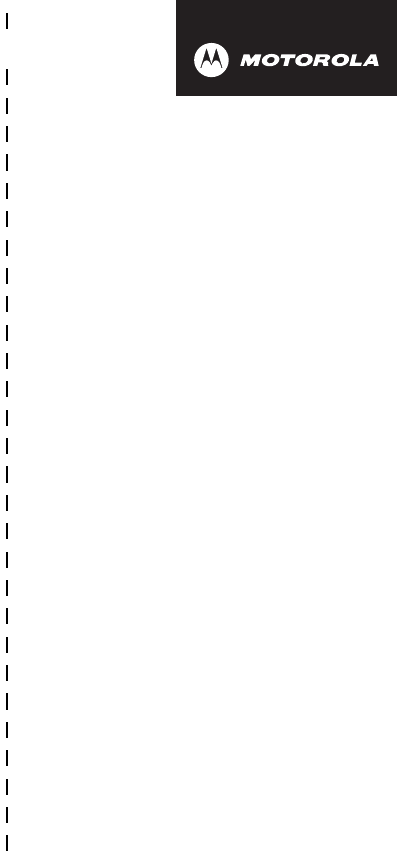
✂
PRELIMINARY
95
art# 020827-O.eps
Wireless Phone Safety
Tips
“Safety is your most important call!”
Your Motorola wireless telephone gives you
the powerful ability to communicate by voice—
almost anywhere, anytime, wherever wireless
phone service is available and safe conditions allow.
But an important responsibility accompanies the
benefits of wireless phones, one that every user
must uphold.
When driving a car, driving is your first
responsibility. If you find it necessary to use your
wireless phone while behind the wheel of a car,
practice good common sense and remember the
following tips:
1 Get to know your Motorola wireless phone and its
features such as speed dial and redial.
If available,
these features help you to place your call without taking
your attention off the road.
2 When available, use a hands-free device.
If possible,
add an additional layer of convenience to your wireless
UG.C330.GSM.book Page 95 Wednesday, January 8, 2003 2:00 PM

✂
PRELIMINARY
96
phone with one of the many Motorola Original™ hands-
free accessories available today.
3 Position your wireless phone within easy reach.
Be
able to access your wireless phone without removing
your eyes from the road. If you receive an incoming call
at an inconvenient time, if possible, let your voice mail
answer it for you.
4 Let the person you are speaking with know you are
driving; if necessary, suspend the call in heavy
traffic or hazardous weather conditions.
Rain, sleet,
snow, ice, and even heavy traffic can be hazardous.
5 If you receive an incoming call at an inconvenient
time do not take notes or look up phone numbers
while driving.
Jotting down a “to do” list or going
through your address book takes attention away from
your primary responsibility—driving safely.
6 Dial sensibly and assess the traffic; if possible,
place calls when you are not moving or before
pulling into traffic.
Try to plan calls when your car will
be stationary. If you need to make a call while moving,
dial only a few numbers, check the road and your
mirrors, then continue.
7 Do not engage in stressful or emotional
conversations that may be distracting.
Make people
you are talking with aware you are driving and suspend
conversations which have the potential to divert your
attention away from the road.
8 Use your wireless phone to call for help.
Dial 9-1-1 or
other local emergency number in the case of fire, traffic
accident or medical emergencies.*
UG.C330.GSM.book Page 96 Wednesday, January 8, 2003 2:00 PM

✂
PRELIMINARY
97
9 Use your wireless phone to help others in
emergencies.
If you see an auto accident, crime in
progress or other serious emergency where lives are in
danger, call 9-1-1 or other local emergency number, as
you would want others to do for you.*
10 Call roadside assistance or a special
non-emergency wireless assistance number when
necessary.
If you see a broken-down vehicle posing no
serious hazard, a broken traffic signal, a minor traffic
accident where no one appears injured, or a vehicle you
know to be stolen, call roadside assistance or other
special non-emergency wireless number.*
* Wherever wireless phone service is available.
UG.C330.GSM.book Page 97 Wednesday, January 8, 2003 2:00 PM

✂
PRELIMINARY
98
Check the laws and regulations on the use of
wireless telephones and their accessories in the
areas where you drive. Always obey them. The
use of these devices may be prohibited or
restricted in certain areas.
For more information,
please call
1-888-901-SAFE
or visit the
CTIA Web site at
www.wow-com.com™
UG.C330.GSM.book Page 98 Wednesday, January 8, 2003 2:00 PM